Normandy, Champagne, and Alsace in May, 2022
#23
Original Poster
Join Date: Jul 2005
Posts: 1,490
Likes: 0
Received 0 Likes
on
0 Posts
Thursday, May 19
Today was our day to see the sites in the British sector, starting with Pegasus Bridge. We waited out a line of storms that moved from West to East across the region, with the rain stopping in Port-en-Bessin around 10:00 a.m We left at 10:30 and arrived at the Pegasus Bridge Museum around 11:00. They had a nice collection of artifacts and explanatory material (including a film), which we checked out before heading outside to see, among other things, the original bridge and a model of a Horsa glider like the one used by the British paratroopers in the assault. The original bridge was moved to this site, adjacent to the canal, when they decided that a new bridge would have to be constructed in order to accommodate widening of the canal. After checking out the museum, we walked across the new bridge in order to have lunch. We chose to eat at the café that has better reviews, Les 3 Planeurs, rather than the historic Dongree Café, which was operated by the same family back on D-Day. We got to see the drawbridge opened couple of times before we headed on to our next stop at Courselles-sur-Mer. This was part of the Juno Beach sector, and although there were some remains of fortifications, the area is very developed, making it hard to picture in your mind what happened here in 1944. We got some nice views of Gold Beach on our way to our next stop, Arromanches-les-Bains, site of one of the two artificial harbors constructed by the Allies. The one in the American sector was so heavily damaged by a storm that occurred on June 19, that it’s parts were cannibalized in order to make repairs to the one in the British sector here at Arromanches-les-Bains.
On our way home, we made a brief stop at the Longues-sur-Mer battery, but did not walk all the way out to the observation post as I was not feeling good. However, after regrouping back at the house for a couple of hours, I wanted to make one more excursion, and that was to see the German bunker sitting above the town on the western flank. You could walk all the way up there, but being the lazy slug that I am, I drove. It’s only a 2 minute drive from the house, but the road is straight up, so I was glad I took the car. There is a little graveled area on the south side of the road at 22 Le Semaphore. This house address worked for Google Maps, but I had to mark a point on my Garmin smart app in order to use the Garmin. Once you reach this point, you walk around a hedge on the north side of the road, which splits a golf course, and turn the corner to walk on a well maintained path that runs behind a green to a monument to the 47th Royal Marines Commando, the outfit that liberated Port-en-Bessin on June 7. The monument sits on top of the bunker, which is in very good shape. You can walk down into the bunker, which was surprisingly dry and not a mess, unlike most of the bunkers that I saw. The commanding view of the coast from Port-en-Bessin to Arromanches-les-Bains makes it evident why the Germans put a bunker here. That was our last site to see while based as Port-en-Bessin, as tomorrow we head to Honfleur, after taking a detour along the way to check out some cheese.
The original bridge on display at the Pegasus Bridge Museum:
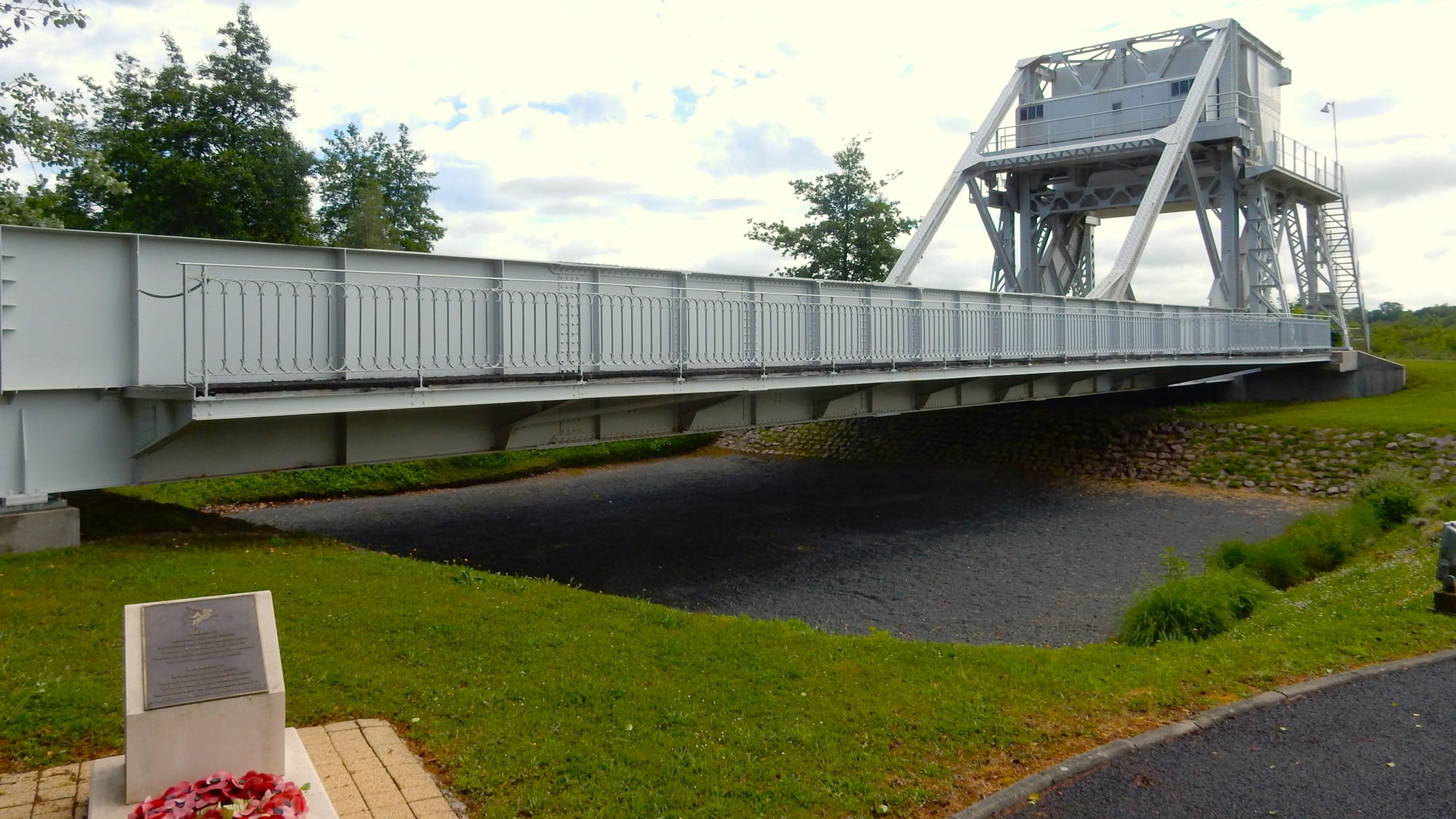
A Horsa glider, like the ones used by the British paratroopers. They managed to land three of these within 100 yards of the bridge, at night, and take the Germans completely by surprise:
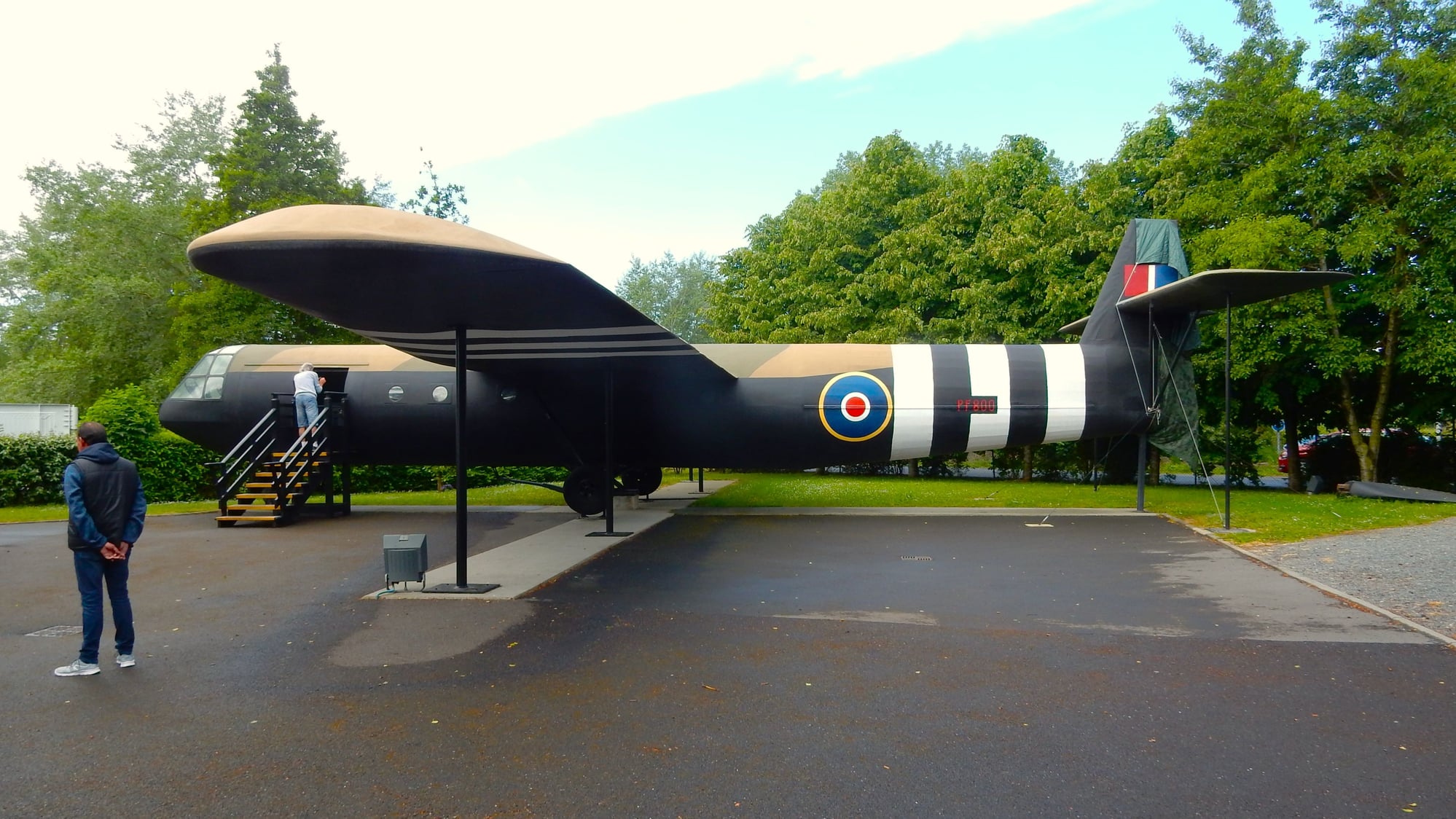
The new bridge opening to let a boat pass:
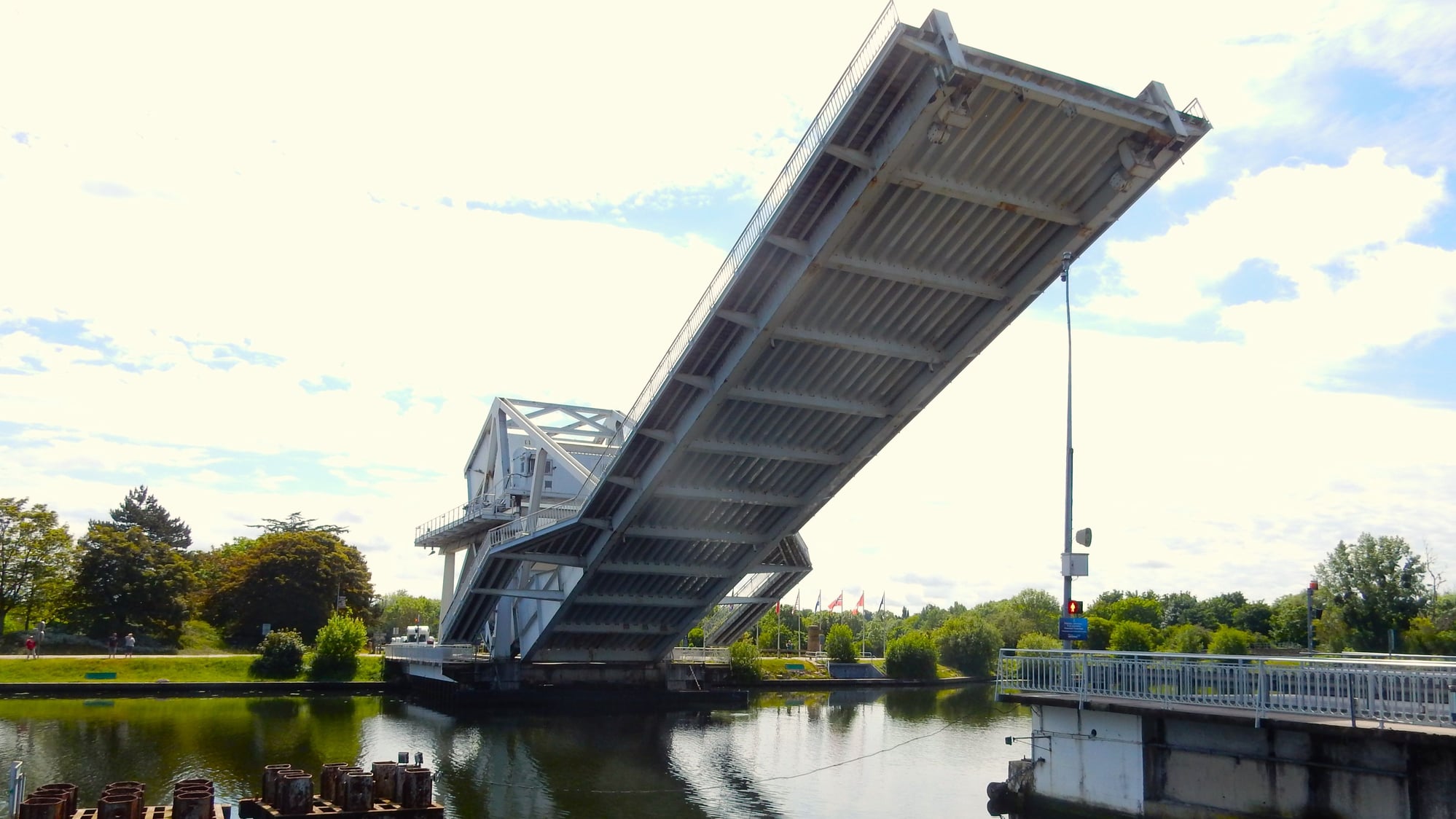
While there are some monuments, and a some fortifications still left on the British beaches, the development of these beaches since the war just makes them a lot less visually appealing for the tourists looking for the history of the invasion:

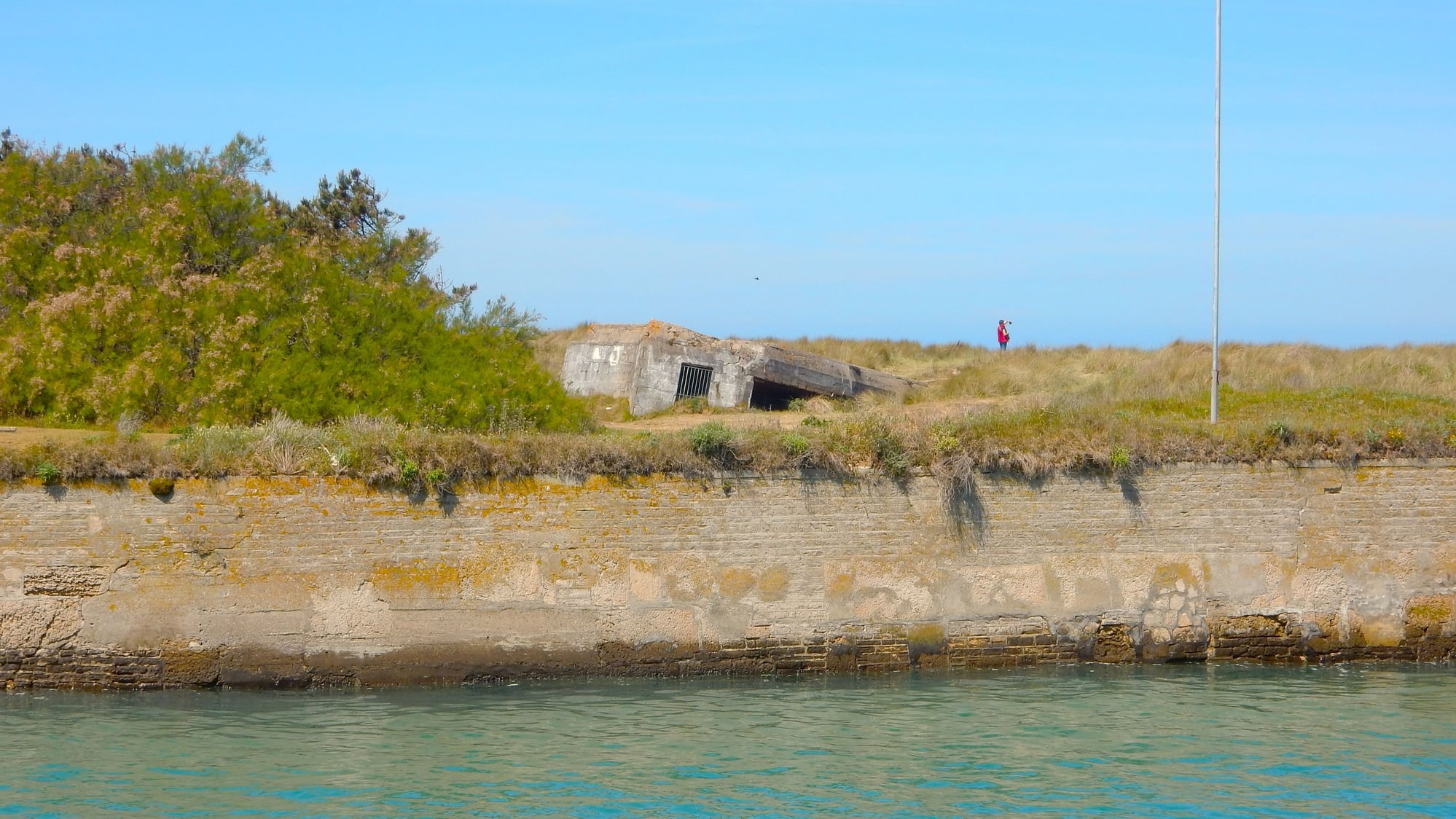
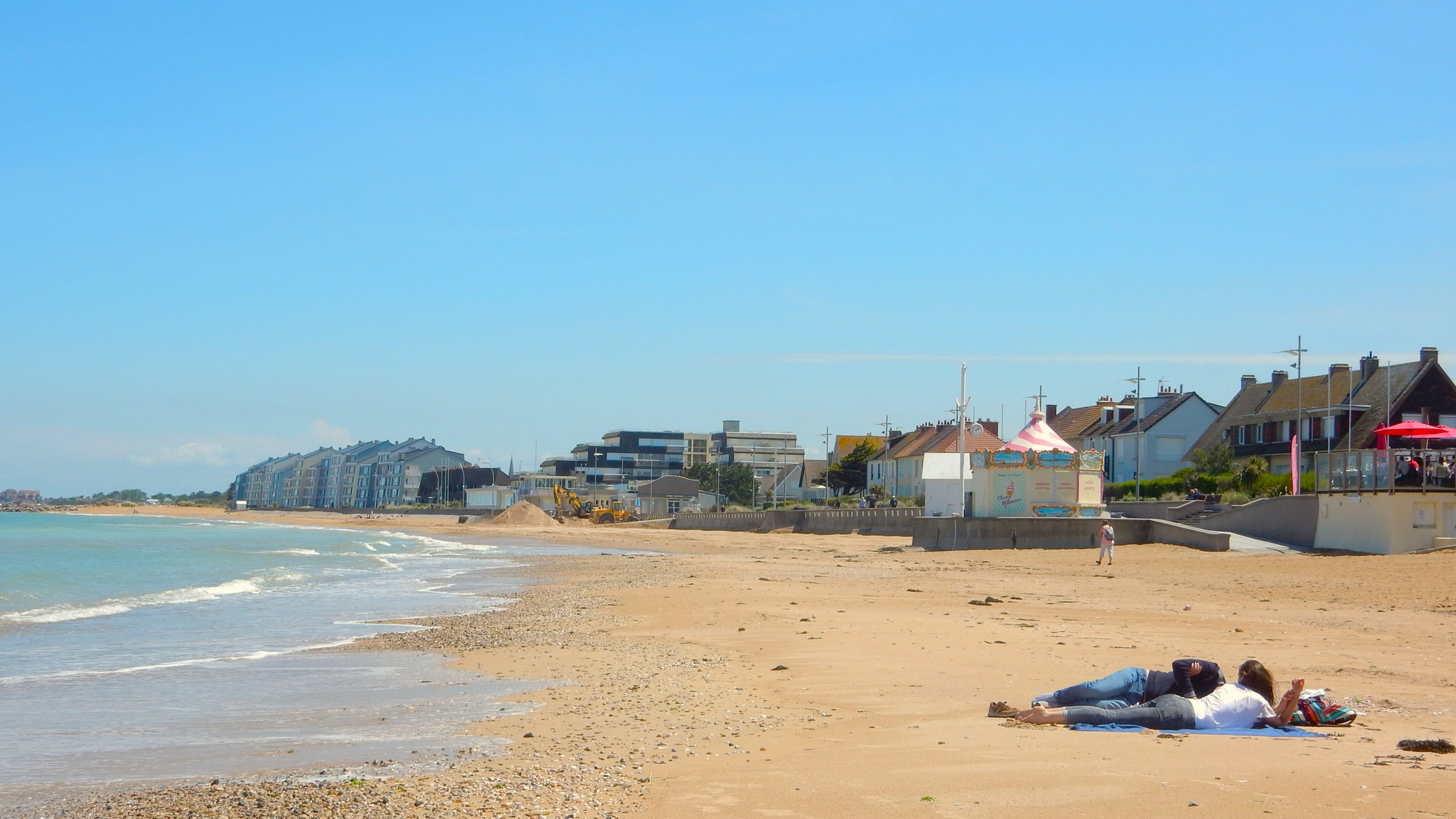
I missed a really good photo opportunity on our way from Juno Beach to Arromanches-les-Bains. There is a place to park on a bluff overlooking the town to the East, so if you make this drive, pull over here for a dramatic view of the remains of the artificial harbor. We could see these in the distance from our rental in Port-en-Bessin, but you can get an up close look in town:

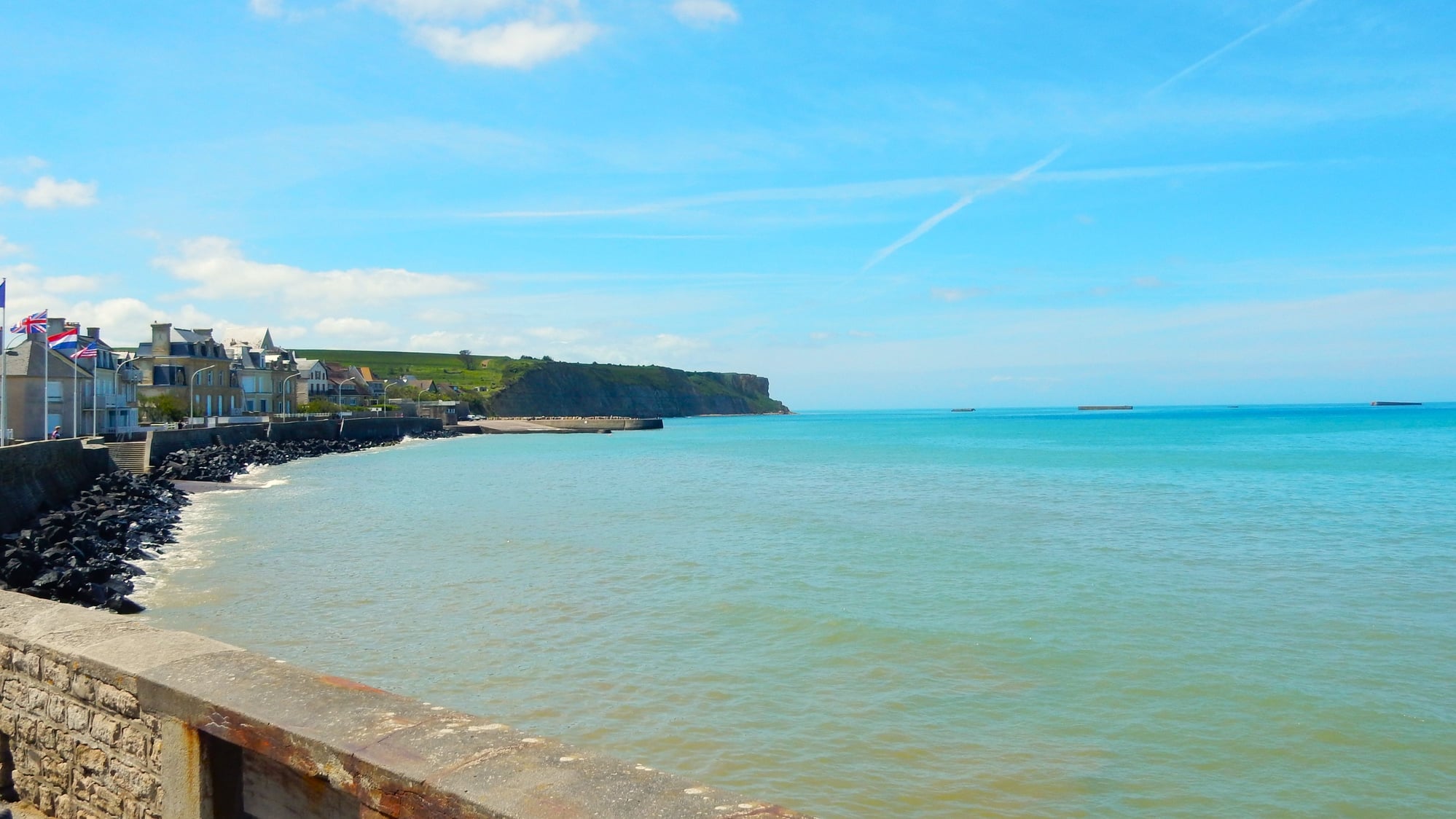
One of the bunkers at Longues-sur-Mer:
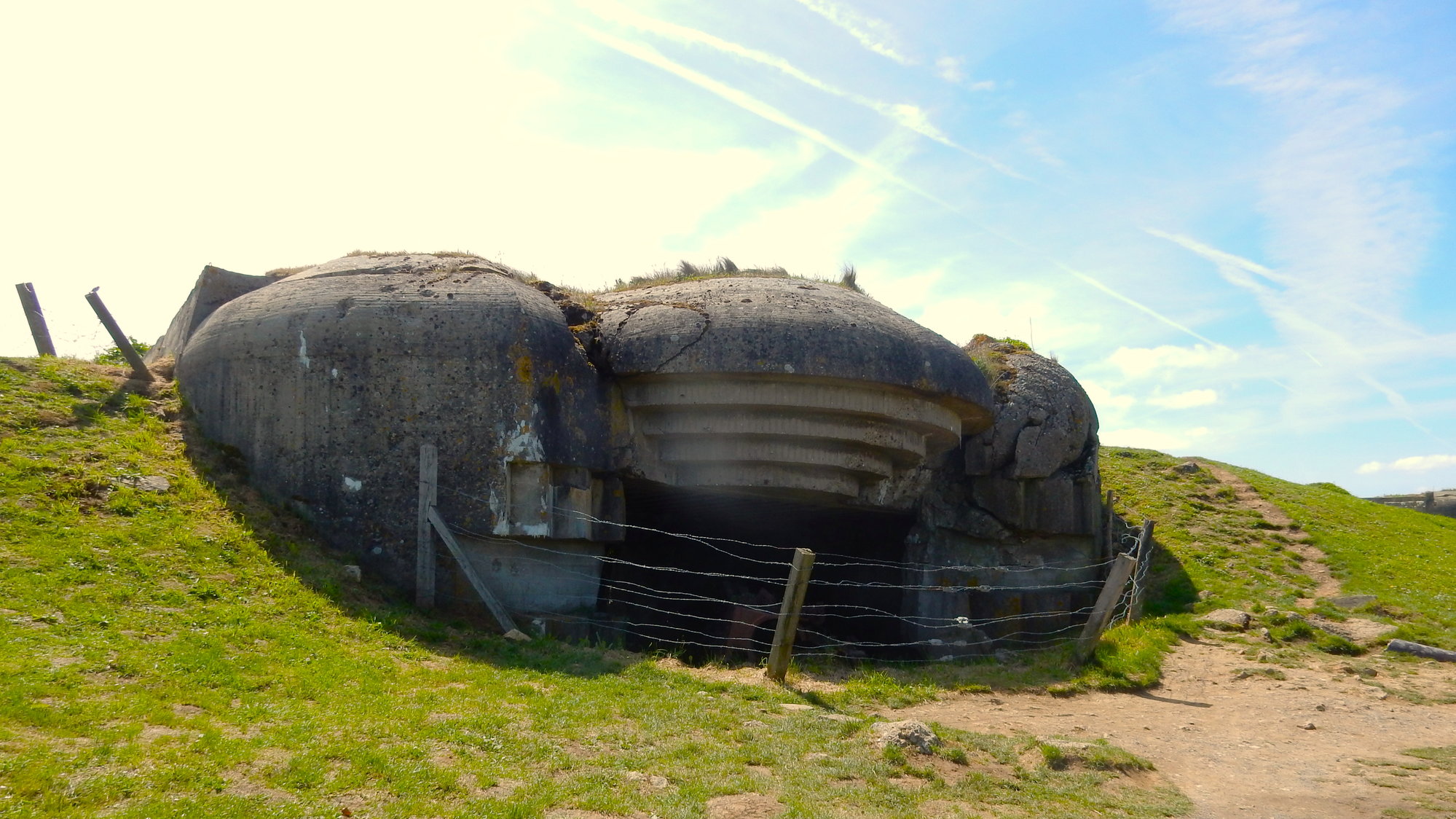
If you go to Port-en-Bessin, it's definitely worth taking 15 minutes to check out the memorial to the 47th Royal Marines Commando that sits on top of the German bunker on the bluff overlooking the town to the West:
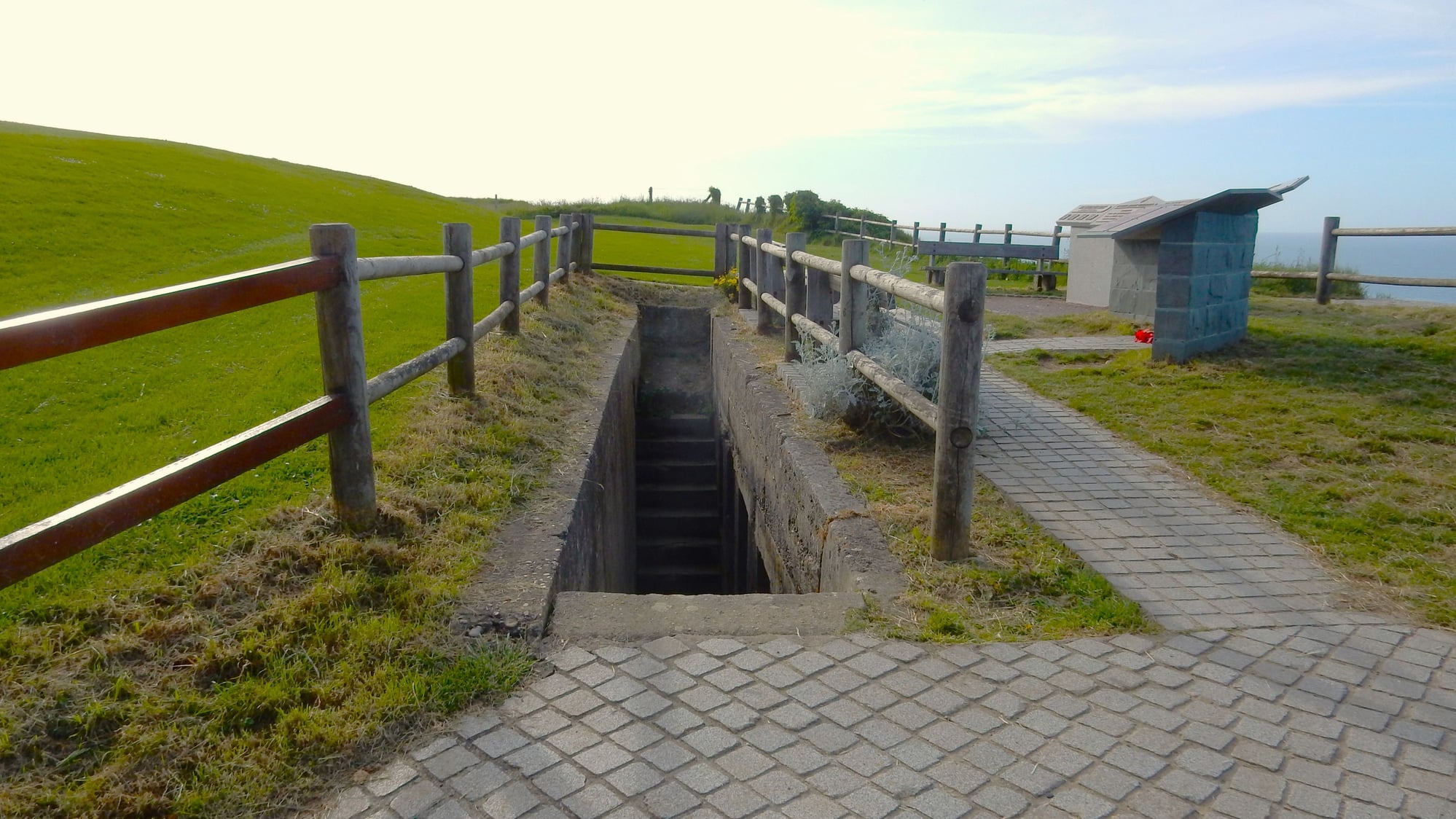

Today was our day to see the sites in the British sector, starting with Pegasus Bridge. We waited out a line of storms that moved from West to East across the region, with the rain stopping in Port-en-Bessin around 10:00 a.m We left at 10:30 and arrived at the Pegasus Bridge Museum around 11:00. They had a nice collection of artifacts and explanatory material (including a film), which we checked out before heading outside to see, among other things, the original bridge and a model of a Horsa glider like the one used by the British paratroopers in the assault. The original bridge was moved to this site, adjacent to the canal, when they decided that a new bridge would have to be constructed in order to accommodate widening of the canal. After checking out the museum, we walked across the new bridge in order to have lunch. We chose to eat at the café that has better reviews, Les 3 Planeurs, rather than the historic Dongree Café, which was operated by the same family back on D-Day. We got to see the drawbridge opened couple of times before we headed on to our next stop at Courselles-sur-Mer. This was part of the Juno Beach sector, and although there were some remains of fortifications, the area is very developed, making it hard to picture in your mind what happened here in 1944. We got some nice views of Gold Beach on our way to our next stop, Arromanches-les-Bains, site of one of the two artificial harbors constructed by the Allies. The one in the American sector was so heavily damaged by a storm that occurred on June 19, that it’s parts were cannibalized in order to make repairs to the one in the British sector here at Arromanches-les-Bains.
On our way home, we made a brief stop at the Longues-sur-Mer battery, but did not walk all the way out to the observation post as I was not feeling good. However, after regrouping back at the house for a couple of hours, I wanted to make one more excursion, and that was to see the German bunker sitting above the town on the western flank. You could walk all the way up there, but being the lazy slug that I am, I drove. It’s only a 2 minute drive from the house, but the road is straight up, so I was glad I took the car. There is a little graveled area on the south side of the road at 22 Le Semaphore. This house address worked for Google Maps, but I had to mark a point on my Garmin smart app in order to use the Garmin. Once you reach this point, you walk around a hedge on the north side of the road, which splits a golf course, and turn the corner to walk on a well maintained path that runs behind a green to a monument to the 47th Royal Marines Commando, the outfit that liberated Port-en-Bessin on June 7. The monument sits on top of the bunker, which is in very good shape. You can walk down into the bunker, which was surprisingly dry and not a mess, unlike most of the bunkers that I saw. The commanding view of the coast from Port-en-Bessin to Arromanches-les-Bains makes it evident why the Germans put a bunker here. That was our last site to see while based as Port-en-Bessin, as tomorrow we head to Honfleur, after taking a detour along the way to check out some cheese.
The original bridge on display at the Pegasus Bridge Museum:

A Horsa glider, like the ones used by the British paratroopers. They managed to land three of these within 100 yards of the bridge, at night, and take the Germans completely by surprise:

The new bridge opening to let a boat pass:

While there are some monuments, and a some fortifications still left on the British beaches, the development of these beaches since the war just makes them a lot less visually appealing for the tourists looking for the history of the invasion:



I missed a really good photo opportunity on our way from Juno Beach to Arromanches-les-Bains. There is a place to park on a bluff overlooking the town to the East, so if you make this drive, pull over here for a dramatic view of the remains of the artificial harbor. We could see these in the distance from our rental in Port-en-Bessin, but you can get an up close look in town:


One of the bunkers at Longues-sur-Mer:

If you go to Port-en-Bessin, it's definitely worth taking 15 minutes to check out the memorial to the 47th Royal Marines Commando that sits on top of the German bunker on the bluff overlooking the town to the West:


#24
This might interest you https://en.wikipedia.org/wiki/Bill_Millin
#25
Original Poster
Join Date: Jul 2005
Posts: 1,490
Likes: 0
Received 0 Likes
on
0 Posts
This might interest you https://en.wikipedia.org/wiki/Bill_Millin
#26
Original Poster
Join Date: Jul 2005
Posts: 1,490
Likes: 0
Received 0 Likes
on
0 Posts
Friday, May 20
Today, we traveled from Port-en-Bessin to Honfleur, with a detour along the way to see the Graindorge Dairy at Livarot. I really thought we would also stop along the way and possibly see some small farms making cheese, cider, or calvados, but a steady rain discouraged any thoughts of stopping. Just getting to Livarot proved a little more difficult than it should have been as the road that leads most directly from Caen to Livarot was closed for construction about 15 kilometers from Livarot. Fortunately, we found an alternative route by simply taking some very small roads a little ways north until we got to a main road. The Graindorge Dairy produces the four A.O.P. cheeses of Normandy (Livarot, which they made popular by being the first to distribute it in Paris, Camembert, Neufchatel, and Pont l'Eveque). The factory is set up for the public to do free self-guided tours, with a path through the factory with Windows to allow you to see various stages of the production process, along with explanatory videos and exhibits. Of course, at the end you go through the shop and can by cheese and other products. They do provide free small samples of the 4 cheeses mentioned above. If you come in July or August, you can also schedule more extensive tasting sessions. They also advise you to come in the morning, rather than in the afternoon, to see the actual cheese making process.
After we got back on the road, the lack of additional stops had us arriving in Honfleur a little before I expected; too early to check in to our hotel, the Best Western Cheval Blanc. So, we took a long lunch, then toured the Satie Museum. I would not recommend this museum unless you are really into avant garde museums, and that has nothing to do with Satie's music. The museum's exhibits seem to have been put together by a frustrated abstract artist. That may be to your taste; it didn’t bother me that much, by my sister, who knows more of the composer's music than I do, was really disappointed. After regrouping at the hotel for a while, we went out for dinner, then called an end to this rather gray day.
Saturday, May 21
The weather was much better today, which was fortunate because Saturday is market day in Honfleur. Our hotel is about 50 yards away from the square around St Catherine's Church where the market is held. If you’ve never been to provincial France, then you need to know to check out what days are market days in the region you are visiting. A good market day is a quality tourist site in its own right, not just for the opportunity to buy local products, but also for the people watching. And, in Honfleur, people watching also involves a lot of dog watching. I felt in Honfleur a bit like I did on Cannon Beach in Oregon last summer, wondering where the dog rental place was because all these dog walkers could not be local. At times, I felt really out of place without a dog leash in my hand. Of course, I’m sure that a lot of these dogs normally reside in Paris (Normandy is sometimes jokingly referred to as Paris's 21st arrondissement), but, still the amount of people traveling with pets was astounding. One reason it probably felt that way is the absence of another kind of tourist that we’ve been accustomed to running into everywhere we’ve been in Europe, and that is Chinese tourists. I’m sure you can chalk that up to Covid, but up to this point, we have seen hardly any Asian tourists, unlike prior trips to Europe in the last decade.
After lunch and the market, we took a boat tour of Honfleur and the mouth of the Seine. The tour lasted about an hour and 20 minutes, and took us under the Pont du Normandie then around the point past Honfleur. The narration was only in French, but we understood enough to get the gist. It was a pleasant way to spend the afternoon on a sunny, temperate day.
I liked the Graindorge Frommagerie, but really had hoped to make some other stops in the Pays d'Auge on this day; alas, the weather did not cooperate
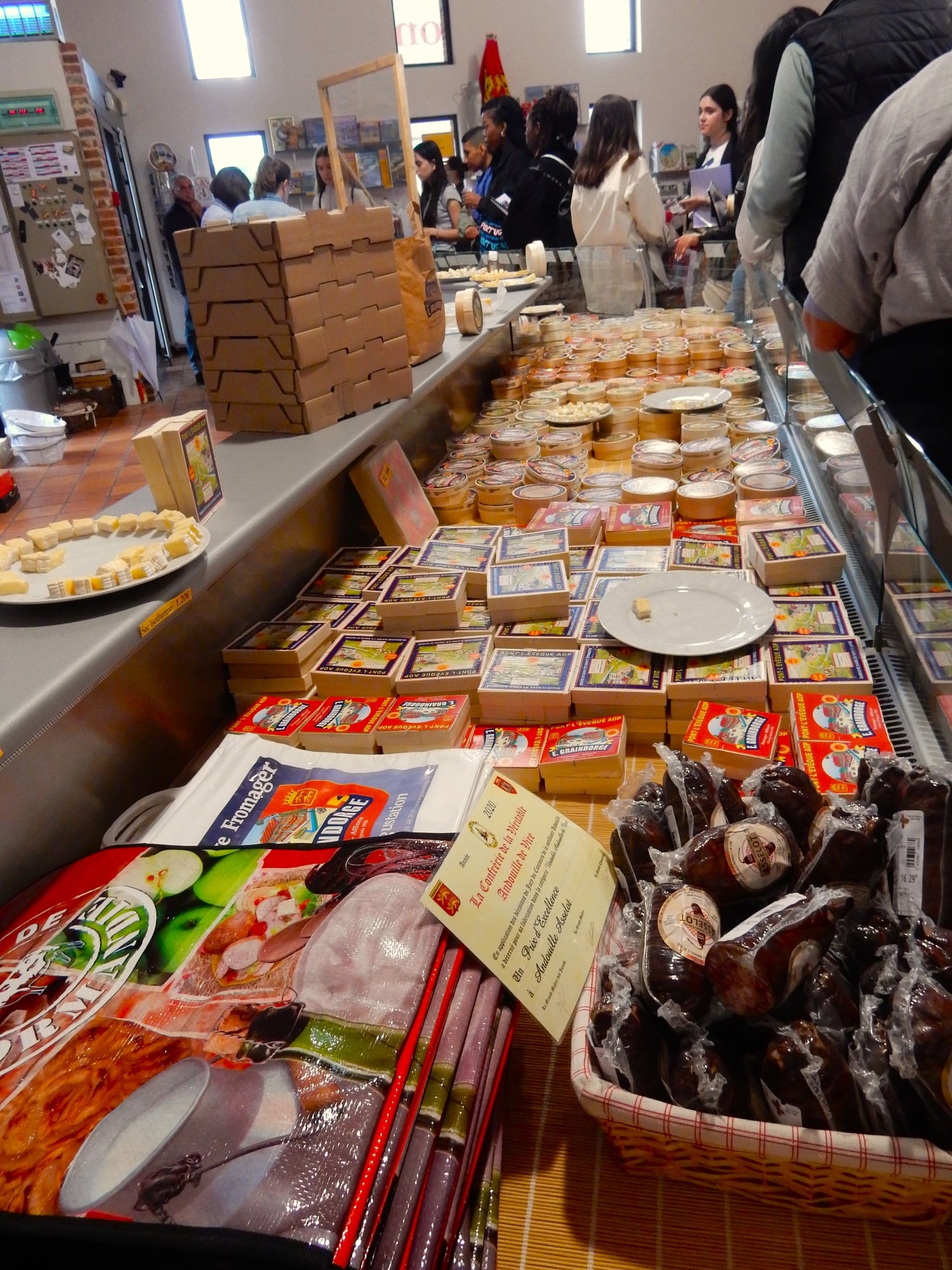
Honfleur probably would have been less crowded during the week, but then we would have missed the market:
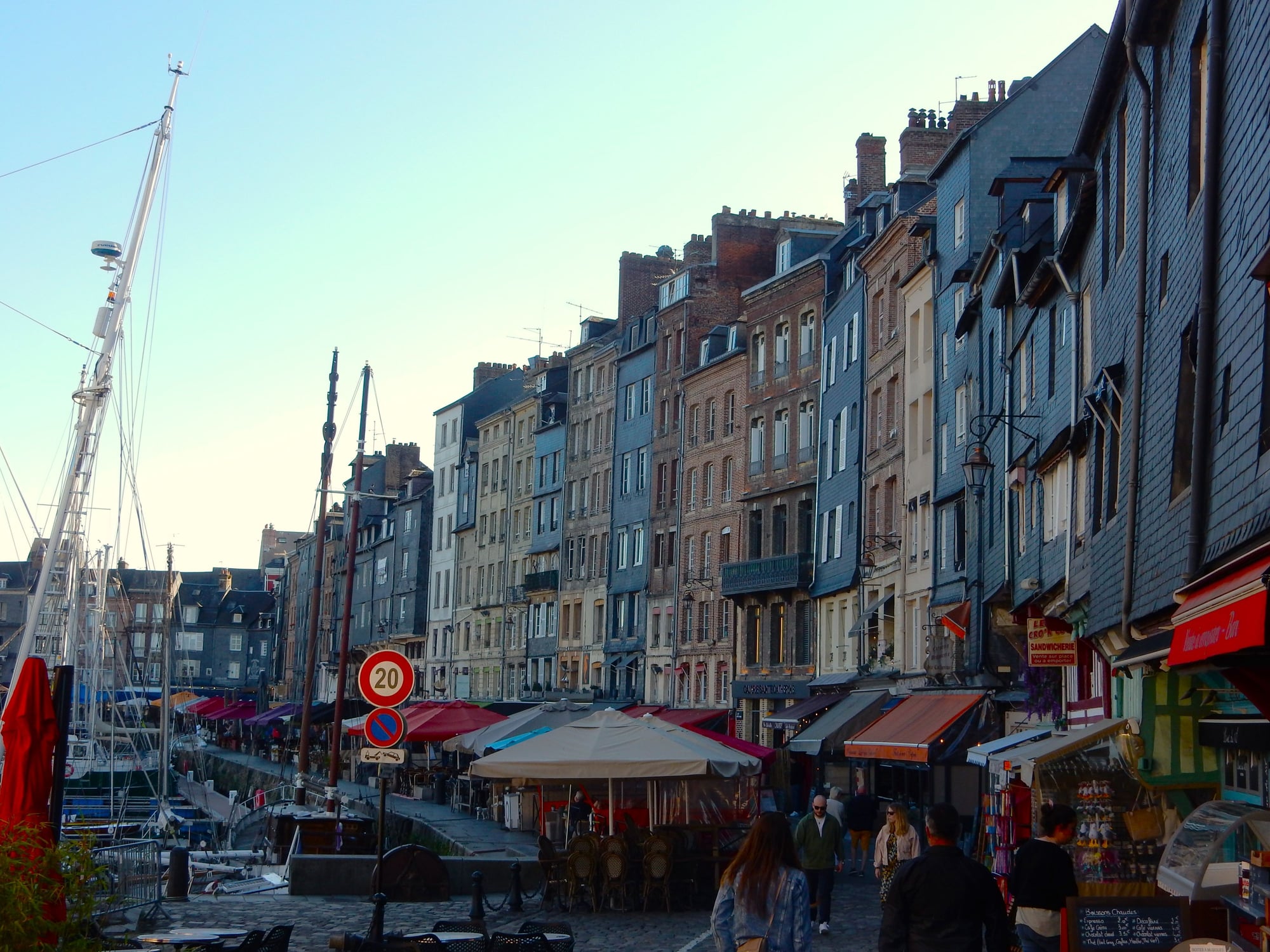
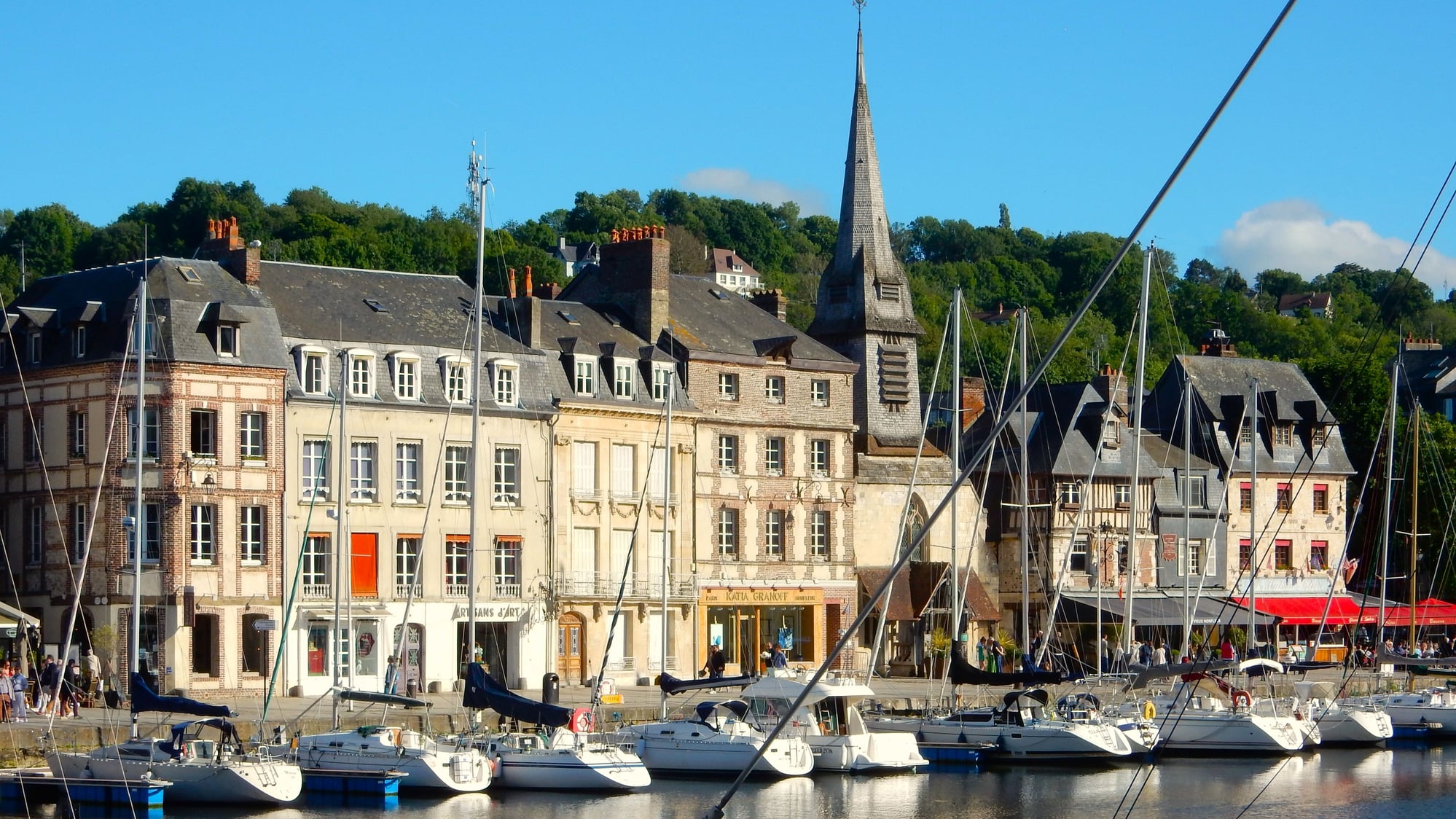

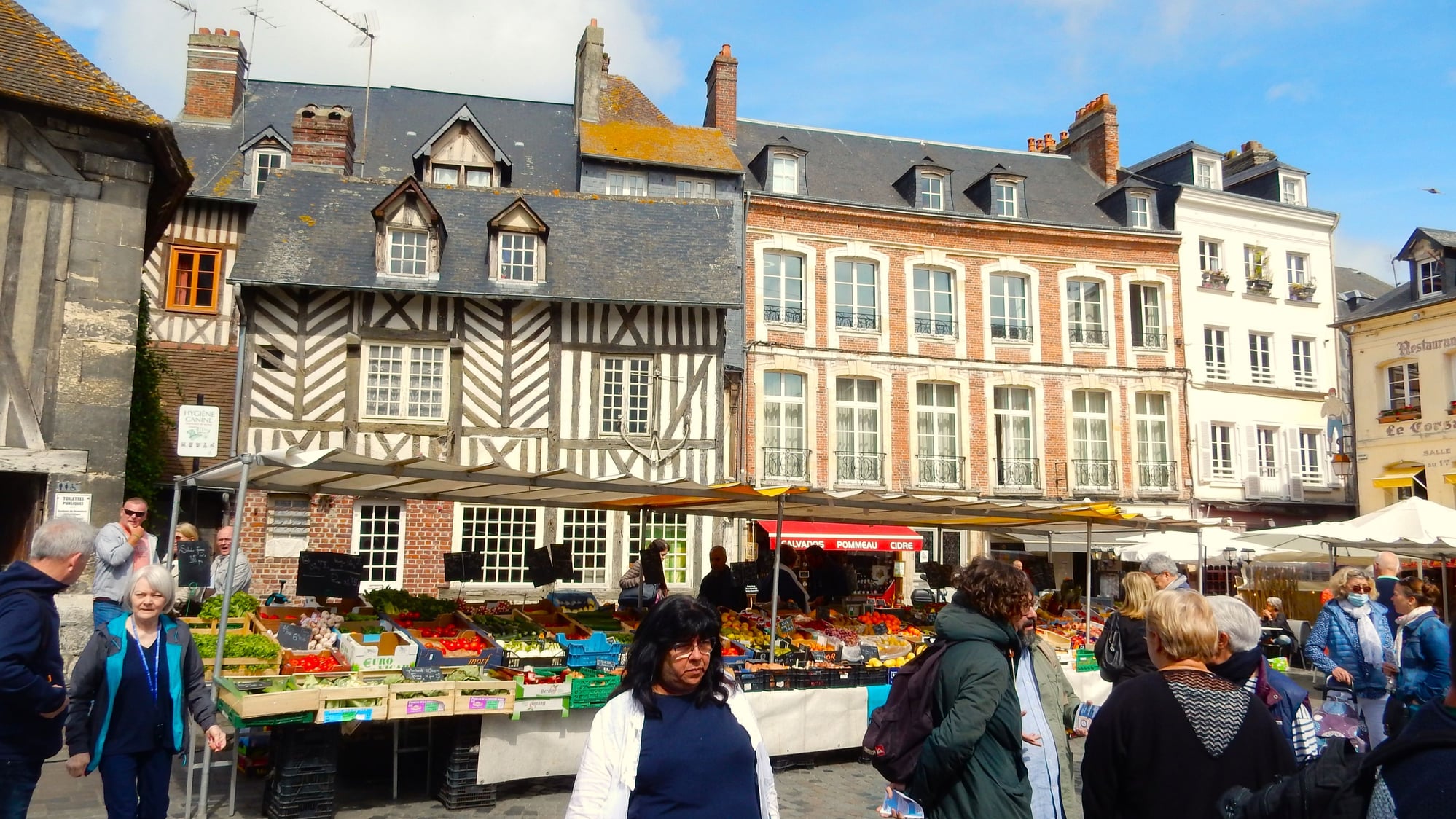

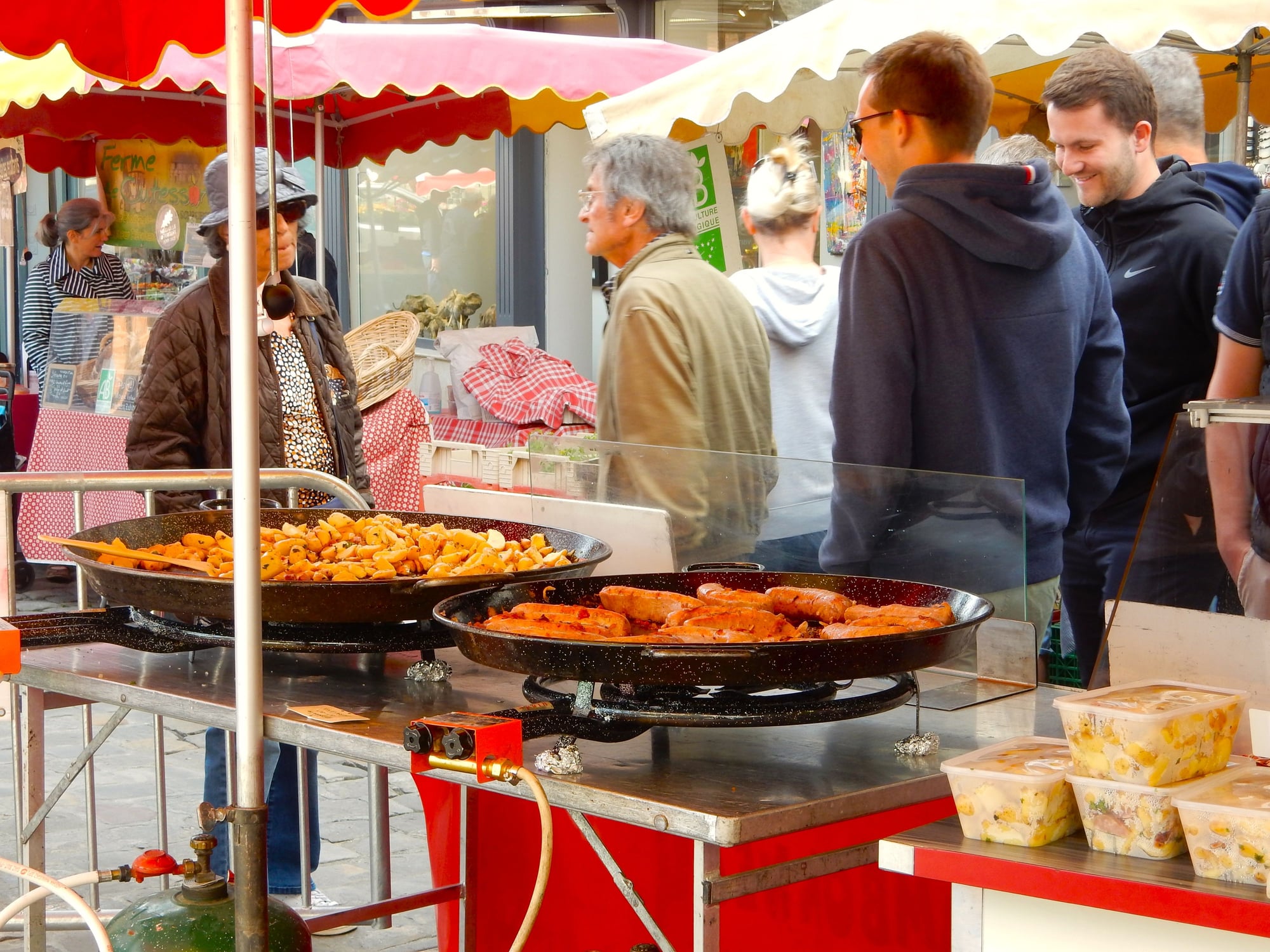

If you find yourself feeling a bit jaded about seeing yet another gothic church, St. Catherine's Church in Honfleur provides a nice contrast is that it is built of wood, and basically in the form of an upside down ship's hull.

The boat excursion to see the Pont de Normandie is not a must do, but it can be a pleasant experience when the weather is good.

The narration on the boat tour was in French, but if I understood correctly, these were wild horses sort of like one sees in the Camargue

Today, we traveled from Port-en-Bessin to Honfleur, with a detour along the way to see the Graindorge Dairy at Livarot. I really thought we would also stop along the way and possibly see some small farms making cheese, cider, or calvados, but a steady rain discouraged any thoughts of stopping. Just getting to Livarot proved a little more difficult than it should have been as the road that leads most directly from Caen to Livarot was closed for construction about 15 kilometers from Livarot. Fortunately, we found an alternative route by simply taking some very small roads a little ways north until we got to a main road. The Graindorge Dairy produces the four A.O.P. cheeses of Normandy (Livarot, which they made popular by being the first to distribute it in Paris, Camembert, Neufchatel, and Pont l'Eveque). The factory is set up for the public to do free self-guided tours, with a path through the factory with Windows to allow you to see various stages of the production process, along with explanatory videos and exhibits. Of course, at the end you go through the shop and can by cheese and other products. They do provide free small samples of the 4 cheeses mentioned above. If you come in July or August, you can also schedule more extensive tasting sessions. They also advise you to come in the morning, rather than in the afternoon, to see the actual cheese making process.
After we got back on the road, the lack of additional stops had us arriving in Honfleur a little before I expected; too early to check in to our hotel, the Best Western Cheval Blanc. So, we took a long lunch, then toured the Satie Museum. I would not recommend this museum unless you are really into avant garde museums, and that has nothing to do with Satie's music. The museum's exhibits seem to have been put together by a frustrated abstract artist. That may be to your taste; it didn’t bother me that much, by my sister, who knows more of the composer's music than I do, was really disappointed. After regrouping at the hotel for a while, we went out for dinner, then called an end to this rather gray day.
Saturday, May 21
The weather was much better today, which was fortunate because Saturday is market day in Honfleur. Our hotel is about 50 yards away from the square around St Catherine's Church where the market is held. If you’ve never been to provincial France, then you need to know to check out what days are market days in the region you are visiting. A good market day is a quality tourist site in its own right, not just for the opportunity to buy local products, but also for the people watching. And, in Honfleur, people watching also involves a lot of dog watching. I felt in Honfleur a bit like I did on Cannon Beach in Oregon last summer, wondering where the dog rental place was because all these dog walkers could not be local. At times, I felt really out of place without a dog leash in my hand. Of course, I’m sure that a lot of these dogs normally reside in Paris (Normandy is sometimes jokingly referred to as Paris's 21st arrondissement), but, still the amount of people traveling with pets was astounding. One reason it probably felt that way is the absence of another kind of tourist that we’ve been accustomed to running into everywhere we’ve been in Europe, and that is Chinese tourists. I’m sure you can chalk that up to Covid, but up to this point, we have seen hardly any Asian tourists, unlike prior trips to Europe in the last decade.
After lunch and the market, we took a boat tour of Honfleur and the mouth of the Seine. The tour lasted about an hour and 20 minutes, and took us under the Pont du Normandie then around the point past Honfleur. The narration was only in French, but we understood enough to get the gist. It was a pleasant way to spend the afternoon on a sunny, temperate day.
I liked the Graindorge Frommagerie, but really had hoped to make some other stops in the Pays d'Auge on this day; alas, the weather did not cooperate

Honfleur probably would have been less crowded during the week, but then we would have missed the market:







If you find yourself feeling a bit jaded about seeing yet another gothic church, St. Catherine's Church in Honfleur provides a nice contrast is that it is built of wood, and basically in the form of an upside down ship's hull.

The boat excursion to see the Pont de Normandie is not a must do, but it can be a pleasant experience when the weather is good.

The narration on the boat tour was in French, but if I understood correctly, these were wild horses sort of like one sees in the Camargue

#27
Original Poster
Join Date: Jul 2005
Posts: 1,490
Likes: 0
Received 0 Likes
on
0 Posts
Sunday, May 22
Today, we left Honfleur and Normandy, bound for Reims and the Champagne region. This was to be our one of our two longest drives, virtually all of it on the autoroute. So, the first half of the day was taken up with some relatively boring driving. We stopped for gas along the way (another 22 litres, this time for 48 euros), arrived in Reims just before noon, found a public parking lot, then headed towards the cathedral, stopping for lunch at a bar a block away before heading inside. The cathedral at Reims is notable for being the location of French coronation starting with that of the first Christian king of France, Clovis. The cathedral is one of the few big structures in town to have survived World War One, although it was burned and heavily damaged by the Germans. As a consequence, only a small amount of the original stained glass survives, but some of the modern replacements are interesting, most notably a section in the apse done by Marc Chagall.
We had intended to tour the adjoining Palace of Tau (former Bishop’s residence next door, that takes its name from its shape in the form of the Greek letter tau), but some kind of puppet festival was being held there on Sunday, and with it being closed on Monday, we decided we would have to write this off. In any event, we wanted to get to our hotel before 3:00 p.m. so that we could check in prior to heading over to the Taittinger champagne caves at 3:45 p.m. for a tour and tasting, one of two we had planned over the next two days. The cellars at Taittinger were huge, partly dating back to Roman to as when the chalk was quarries as a building material. When they started making wine in the region, they realized that the chalk caves made the perfect place to store win at a constant temperature and humidity. At Taittinger, they let you use flash photography, so it was easy to get good photos, and the tour guide was also very entertaining. It was also nice that they let us take the elevator as the caves here were pretty deep (most people take the stairs, but they will let those with mobility issues use the elevator). At the end of the tour, you have a tasting of one to three champagnes, depending on what you paid for. We opted for the basic package (one), although we did buy a small bottle of rose champagne to have later at the obligatory gift shop stop that seems to end every tour. We got back to the hotel around 5:00 p.m., stopping to grab a sandwich to take back along the way, then spent the next 2 hours watching the final round of English Premier League soccer matches on French TV, which did not disappoint for drama.
Monday, May 23
With rain in the forecast, we were glad to have another indoor activity lined up, that being a 10:00 a.m tour of Moet at Chandon in Epernay, just south of Reims. The caves at Moet, having been 100% purpose dug by the Moet family for wine storage starting in 1743, were not quite as impressive as at Taittinger, and no flash photography was allowed, I suppose to avoid any ultraviolet light (they went to pains to point out that they used special lights in the cave with no ultraviolet), but the tour guide did an excellent job of explaining the process of making champagne, showing us the sediment that is created during the second fermentation (which takes place in the bottle that you eventually purchase, after it has been stored in the cellars for a couple of years, the first fermentation having taken place in stainless steel casks over the first year), how the bottles are then tilted downward to allow the sediment to gather at the top of the bottle, then removed, in most cases by sticking the neck of the bottle in a solution of freezing liquid, which freezes the sediment, and which is expelled when the bottle caps placed on the bottle for the second fermentation are removed, at which point a liqueur mix containing wine and sugar is added to top off the bottle and stop the fermentation, then the cork applied (all in a matter of seconds). For the large magnums, which are too big for bottle caps, they have to do the disgorgement by hand, very carefully tilting the bottle to create an air bubble between the sediment and the liquid, then removing the cork caps, held in place with metal, to add the dosage as with other champagne.
After the tour of the caves, we had lunch in Epernay before taking a driving tour of the vineyards between Reims and Epernay, then heading back to the hotel. With periodic light rain, it was not an ideal day for the driving tour. Under better conditions, I would have stopped in the beautiful village of Hautvillers, where Dom Perignon is buried, and spent some time there. If you come this way, however, you sort of have to expect that as they get rain an average of 200 days per year. The reason this region produces champagne rather than still wine is that it was as far north as you could produce wine, so the quality was marginal compared to wine produced in points south of here. Now, however, the producers here are buying fields in the south of England (Kent), which they expect to produce good sparking wine (can't call it champagne because of doesn’t come from the Champagne region) in a few years.
Reims Cathedral: the site of French coronations from the time of Clovis
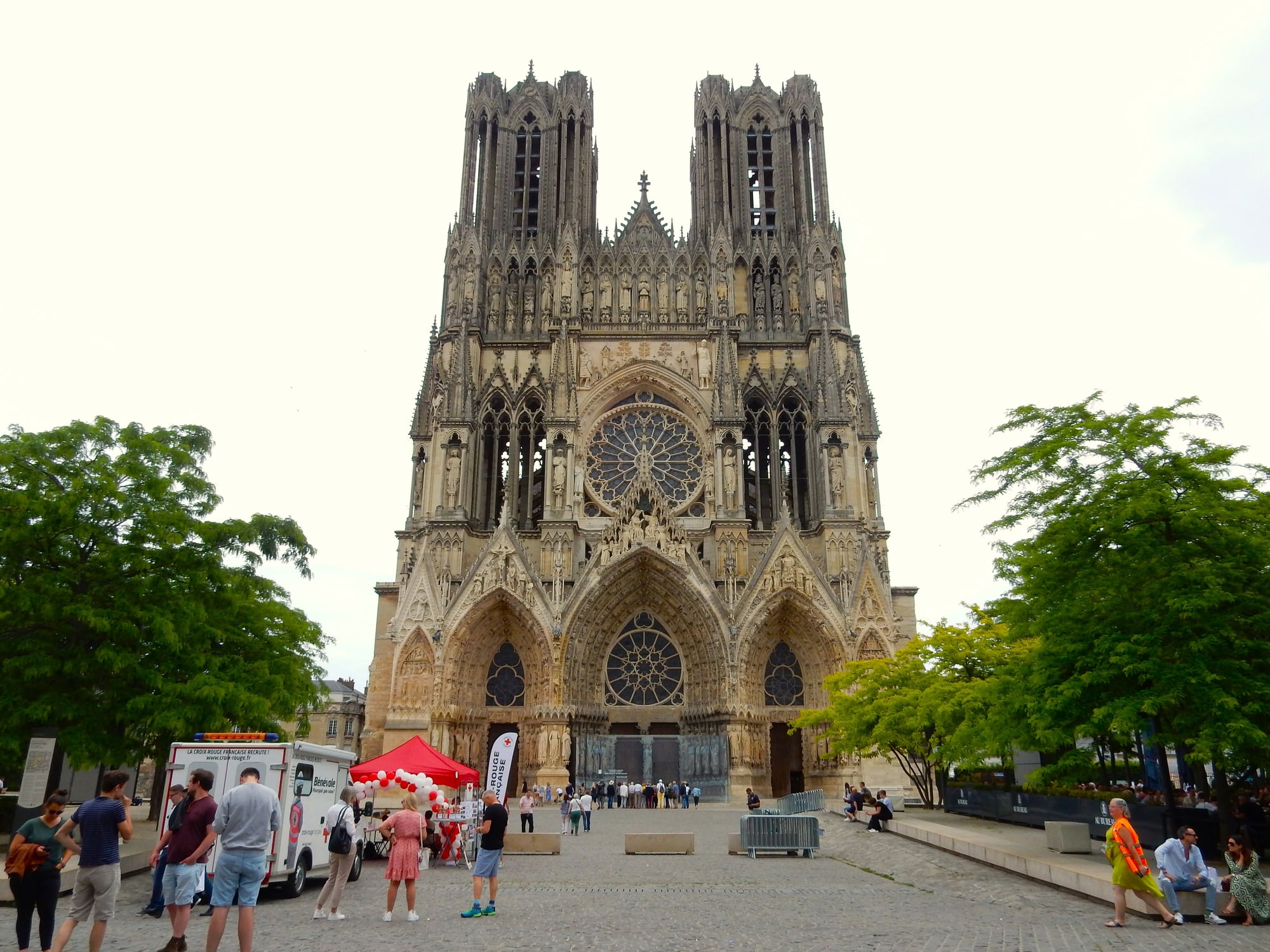


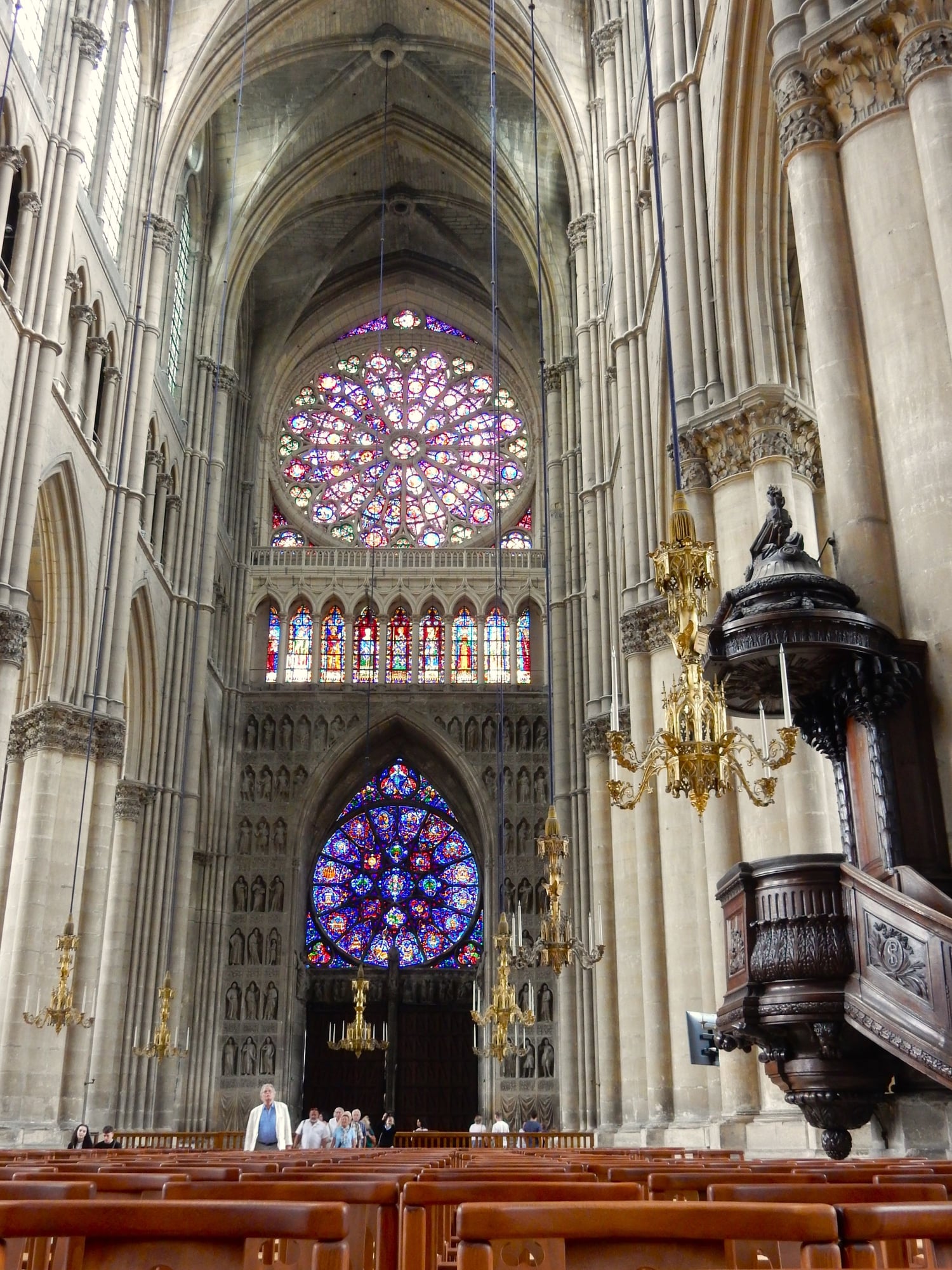
The cellars at Taittinger are great for photography as they allow you to use flash:

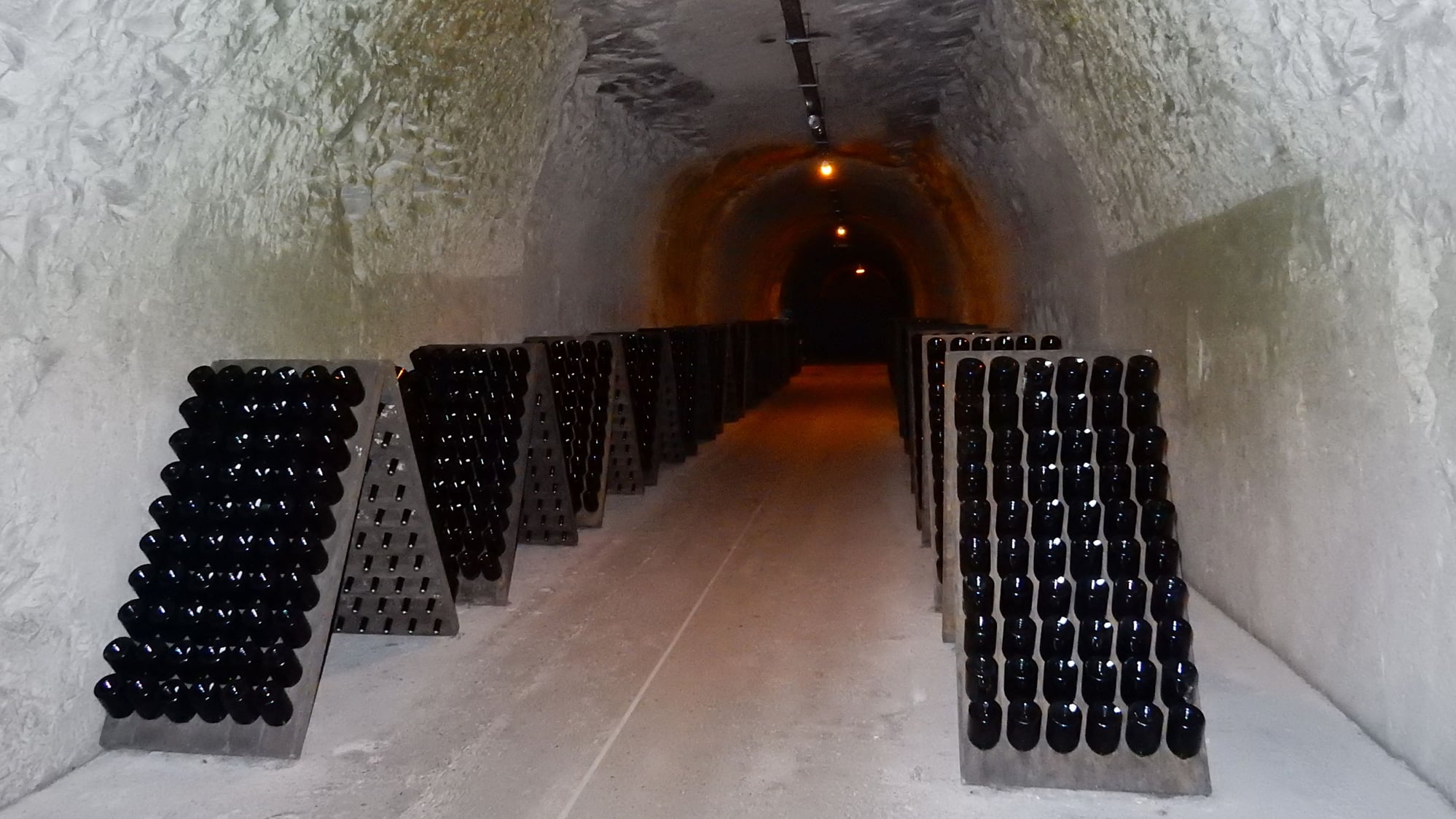
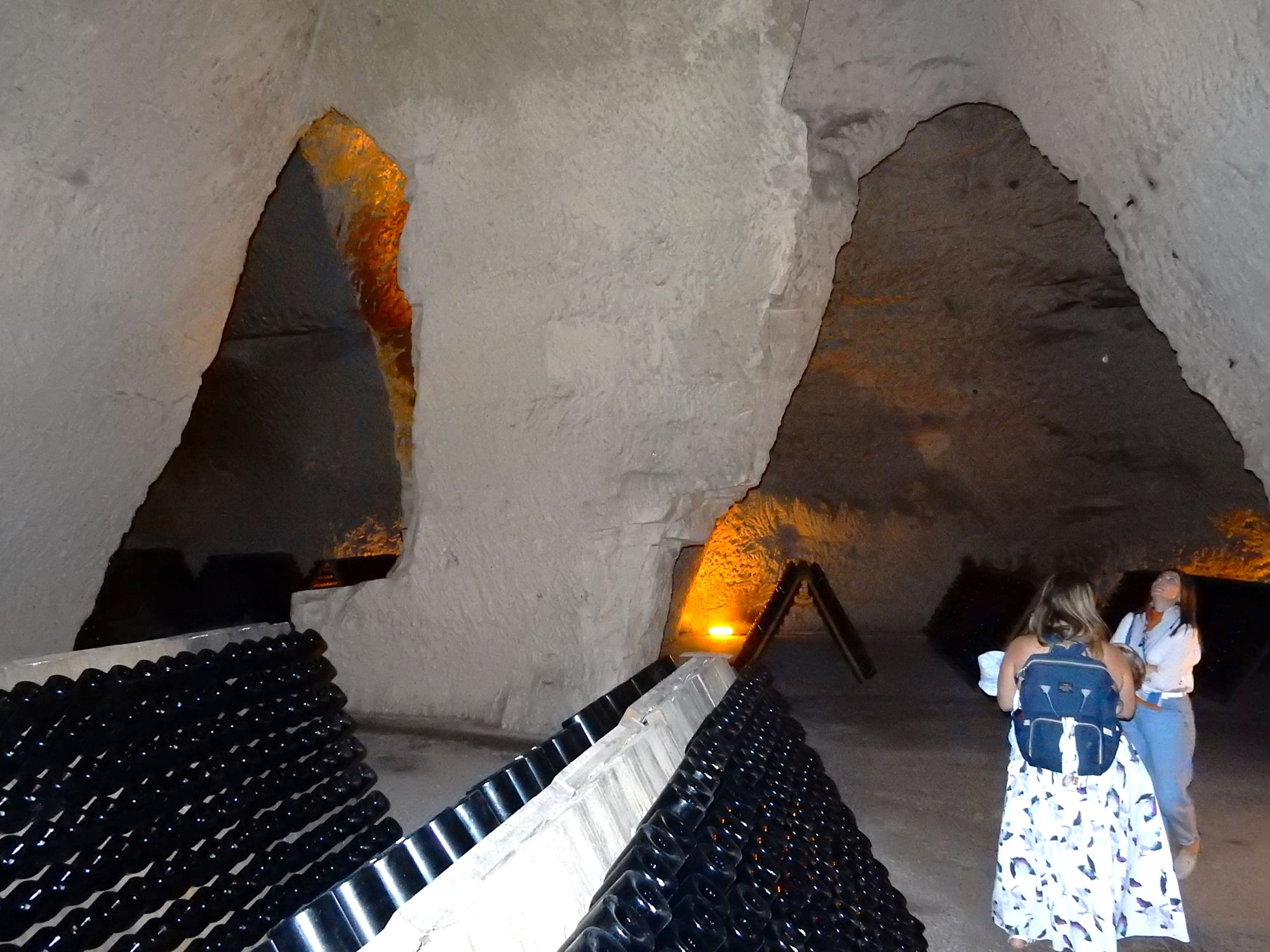

The tour guide at Moet et Chandon did an excellent job of walking you through the champagne making process

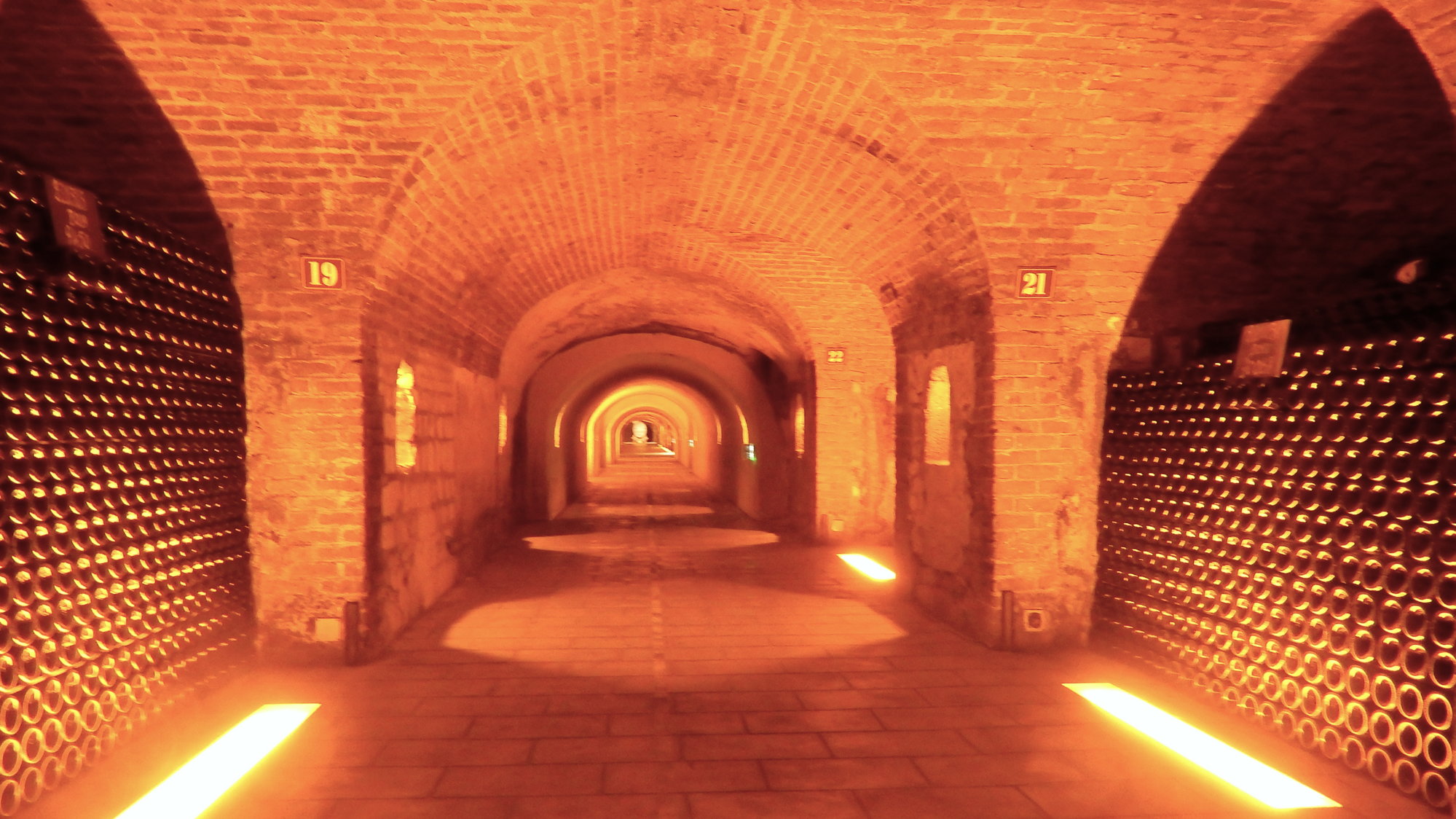
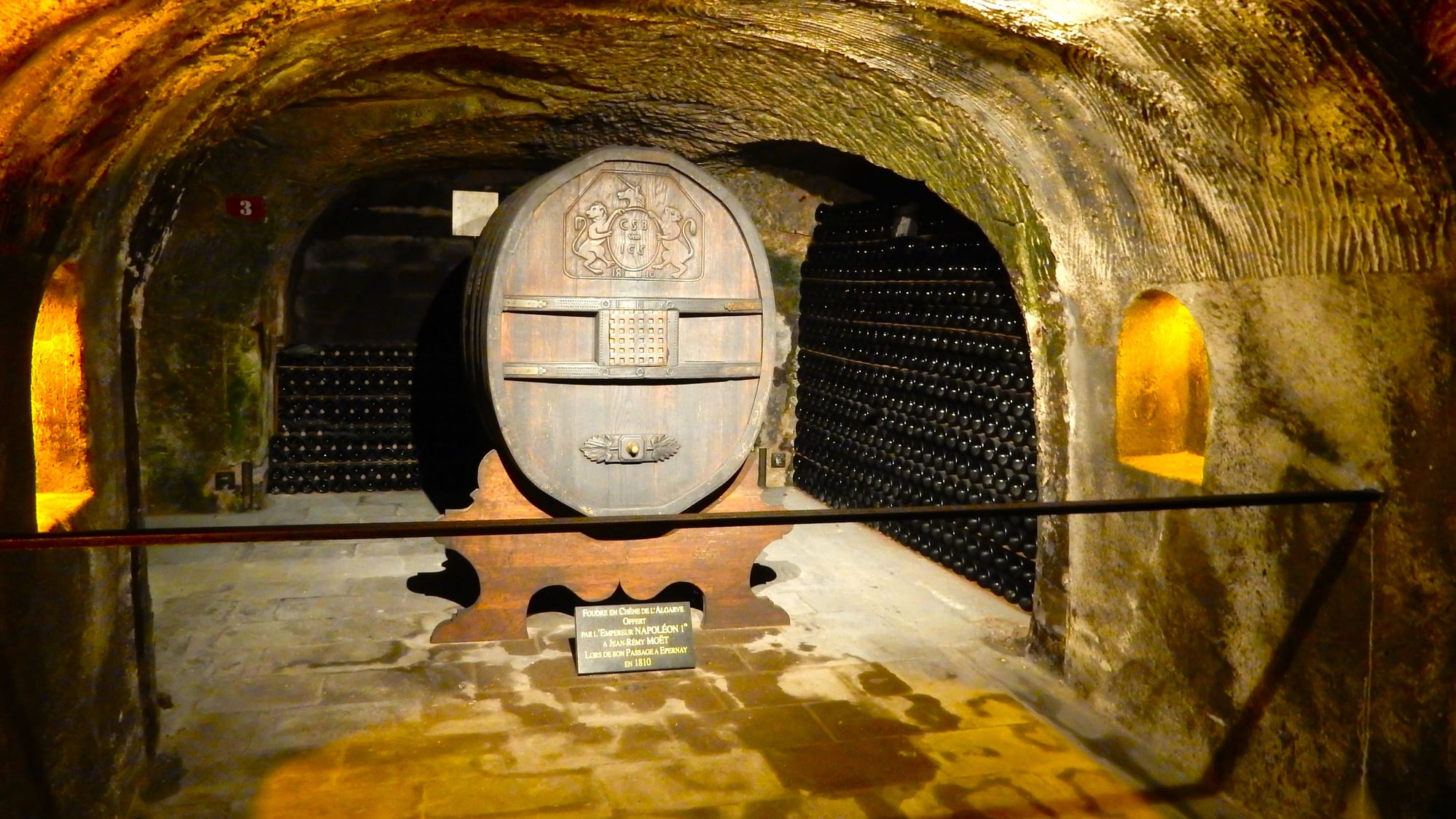
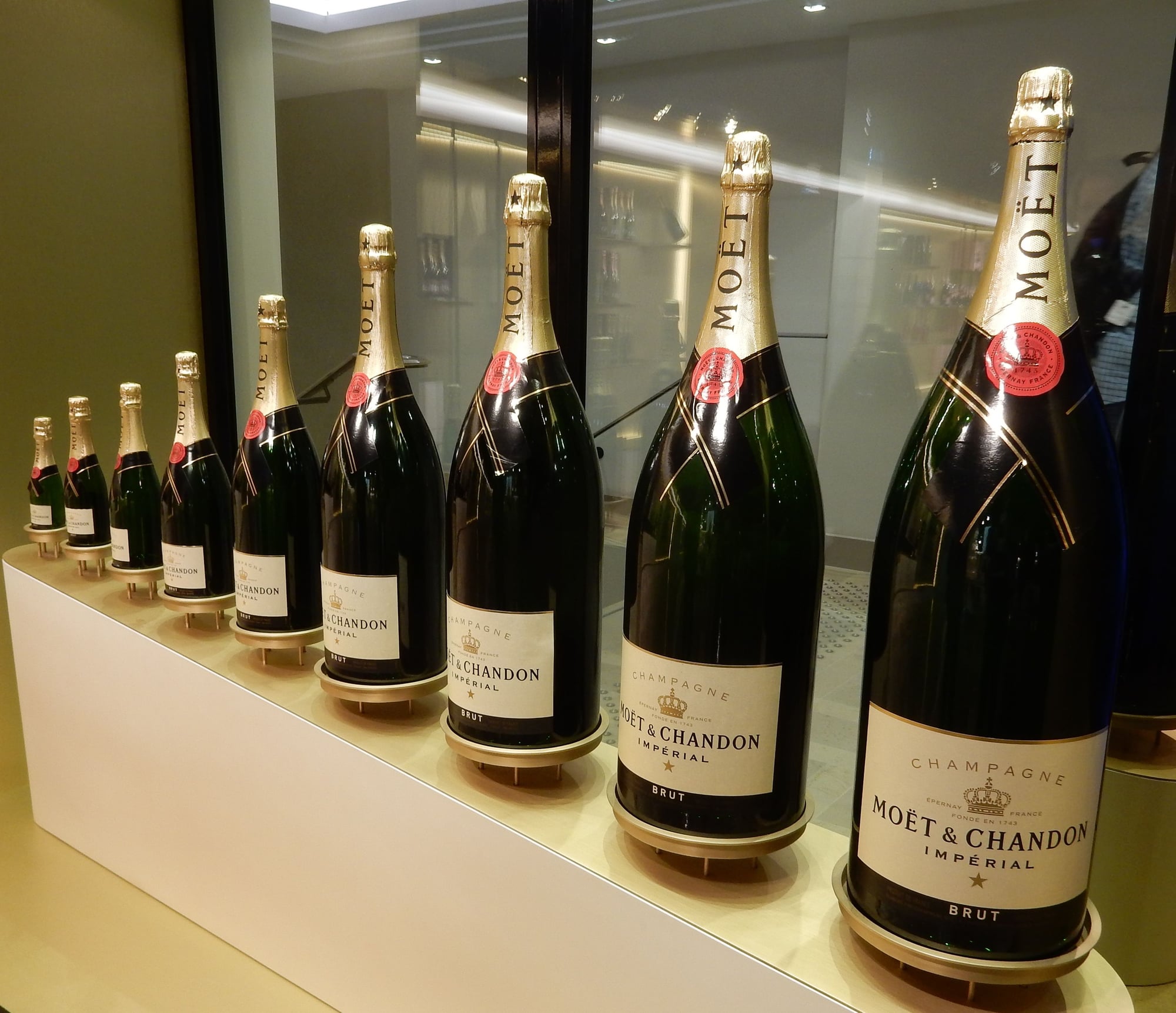
It was unfortunate that the weather did not cooperate for our drive through the vineyards. The area around Hatuvillers was particularly attractive, as was the town itself
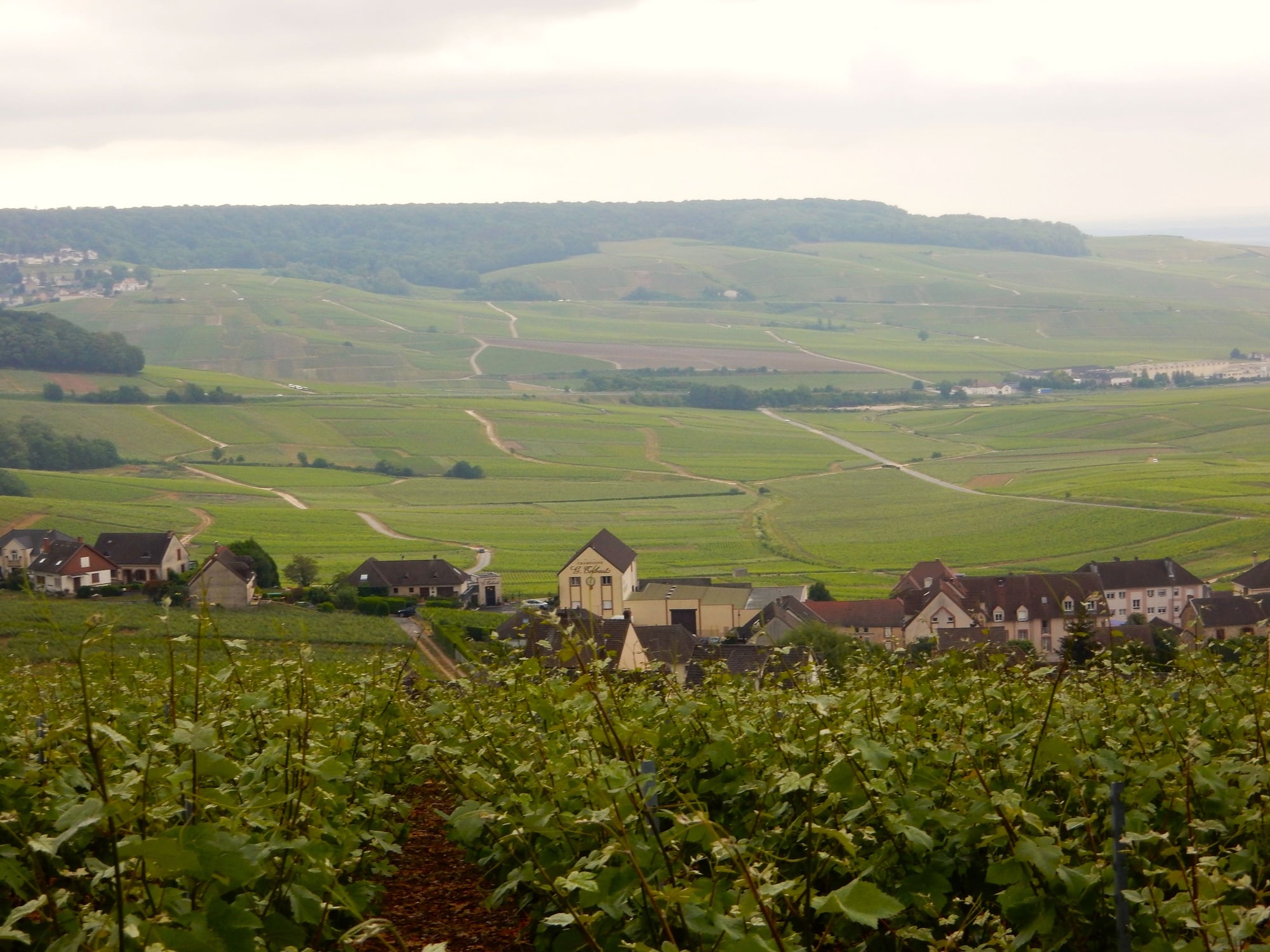
Today, we left Honfleur and Normandy, bound for Reims and the Champagne region. This was to be our one of our two longest drives, virtually all of it on the autoroute. So, the first half of the day was taken up with some relatively boring driving. We stopped for gas along the way (another 22 litres, this time for 48 euros), arrived in Reims just before noon, found a public parking lot, then headed towards the cathedral, stopping for lunch at a bar a block away before heading inside. The cathedral at Reims is notable for being the location of French coronation starting with that of the first Christian king of France, Clovis. The cathedral is one of the few big structures in town to have survived World War One, although it was burned and heavily damaged by the Germans. As a consequence, only a small amount of the original stained glass survives, but some of the modern replacements are interesting, most notably a section in the apse done by Marc Chagall.
We had intended to tour the adjoining Palace of Tau (former Bishop’s residence next door, that takes its name from its shape in the form of the Greek letter tau), but some kind of puppet festival was being held there on Sunday, and with it being closed on Monday, we decided we would have to write this off. In any event, we wanted to get to our hotel before 3:00 p.m. so that we could check in prior to heading over to the Taittinger champagne caves at 3:45 p.m. for a tour and tasting, one of two we had planned over the next two days. The cellars at Taittinger were huge, partly dating back to Roman to as when the chalk was quarries as a building material. When they started making wine in the region, they realized that the chalk caves made the perfect place to store win at a constant temperature and humidity. At Taittinger, they let you use flash photography, so it was easy to get good photos, and the tour guide was also very entertaining. It was also nice that they let us take the elevator as the caves here were pretty deep (most people take the stairs, but they will let those with mobility issues use the elevator). At the end of the tour, you have a tasting of one to three champagnes, depending on what you paid for. We opted for the basic package (one), although we did buy a small bottle of rose champagne to have later at the obligatory gift shop stop that seems to end every tour. We got back to the hotel around 5:00 p.m., stopping to grab a sandwich to take back along the way, then spent the next 2 hours watching the final round of English Premier League soccer matches on French TV, which did not disappoint for drama.
Monday, May 23
With rain in the forecast, we were glad to have another indoor activity lined up, that being a 10:00 a.m tour of Moet at Chandon in Epernay, just south of Reims. The caves at Moet, having been 100% purpose dug by the Moet family for wine storage starting in 1743, were not quite as impressive as at Taittinger, and no flash photography was allowed, I suppose to avoid any ultraviolet light (they went to pains to point out that they used special lights in the cave with no ultraviolet), but the tour guide did an excellent job of explaining the process of making champagne, showing us the sediment that is created during the second fermentation (which takes place in the bottle that you eventually purchase, after it has been stored in the cellars for a couple of years, the first fermentation having taken place in stainless steel casks over the first year), how the bottles are then tilted downward to allow the sediment to gather at the top of the bottle, then removed, in most cases by sticking the neck of the bottle in a solution of freezing liquid, which freezes the sediment, and which is expelled when the bottle caps placed on the bottle for the second fermentation are removed, at which point a liqueur mix containing wine and sugar is added to top off the bottle and stop the fermentation, then the cork applied (all in a matter of seconds). For the large magnums, which are too big for bottle caps, they have to do the disgorgement by hand, very carefully tilting the bottle to create an air bubble between the sediment and the liquid, then removing the cork caps, held in place with metal, to add the dosage as with other champagne.
After the tour of the caves, we had lunch in Epernay before taking a driving tour of the vineyards between Reims and Epernay, then heading back to the hotel. With periodic light rain, it was not an ideal day for the driving tour. Under better conditions, I would have stopped in the beautiful village of Hautvillers, where Dom Perignon is buried, and spent some time there. If you come this way, however, you sort of have to expect that as they get rain an average of 200 days per year. The reason this region produces champagne rather than still wine is that it was as far north as you could produce wine, so the quality was marginal compared to wine produced in points south of here. Now, however, the producers here are buying fields in the south of England (Kent), which they expect to produce good sparking wine (can't call it champagne because of doesn’t come from the Champagne region) in a few years.
Reims Cathedral: the site of French coronations from the time of Clovis




The cellars at Taittinger are great for photography as they allow you to use flash:




The tour guide at Moet et Chandon did an excellent job of walking you through the champagne making process




It was unfortunate that the weather did not cooperate for our drive through the vineyards. The area around Hatuvillers was particularly attractive, as was the town itself

#29
Original Poster
Join Date: Jul 2005
Posts: 1,490
Likes: 0
Received 0 Likes
on
0 Posts
Tuesday, May 24
We moved on from Reims and Champagne to the battlefields of Verdun. After grabbing lunch in town, and getting some gas (23 litres for 46 euros), we proceeded to the Verdun Memorial, a fantastic museum located along a road with many battle sites. This may be the best battlefield museum I have ever visited. It has a ton of artifacts, ranging from large (artillery and aircraft) to small (everything in a soldier's standard issue kit, right down to his underwear). The uniform display was ingenious, as they displayed the coat, headgear and other items in conventional fashion, but then, under that display, they would have a bunch of drawers that you could open, displaying other items in the uniform or standard issue equipment. The story boards and films provided an overview of the war and how the 1916 battle of Verdun fit into the big picture, but then went into great detail on the battle. We spent an hour and a half here and could have spent more.
The next stop was the Douamont Ossuary and the adjoining French cemetery. Paying the 6 euro admission to go inside the Ossuary was a waste of money, while the cemetery was worth a stop. The final site along the road was Fort Douamont, a large subterranean gun battery. Here, there is an admission charge to get inside, but no charge to climb the exterior. Again, as with the Ossuary, I felt like the interior was not worth paying to see, but the climb to the top on the exterior was worth the trouble, showing the gun emplacements, shell craters, and the commanding view of the surrounding countryside. We returned to town, checked in to our hotel, then had dinner just down the street at a local favorite where the menu was written on a chalkboard and the place ended up being packed by 8:00.
Verdun has some sites in town, including a cathedral that survived the war and the underground citadel that served as a hub for troops moving to or back from the front, but we did not venture much beyond our initial look around the riverfront area.
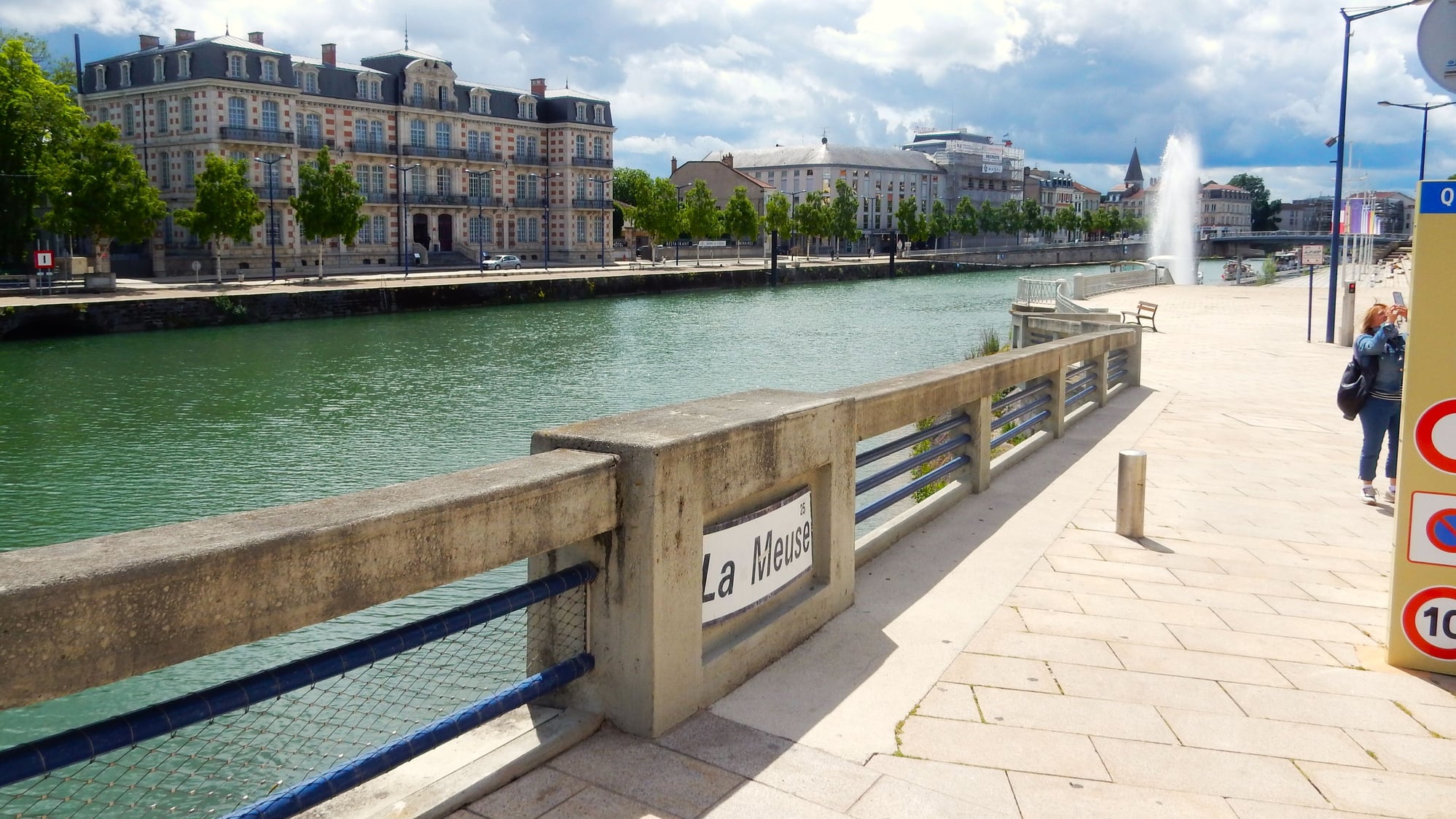
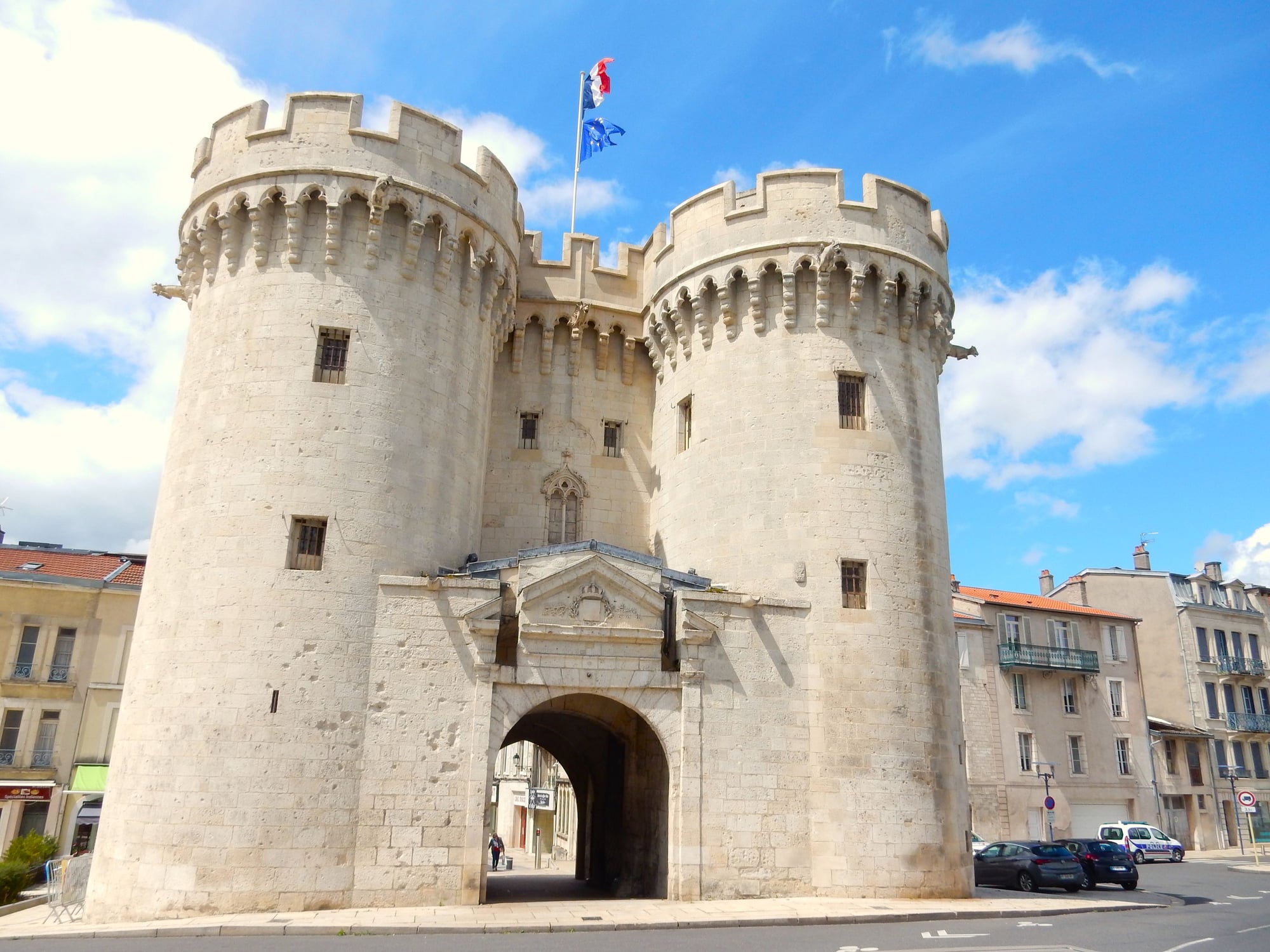


The Memorial de Verdun is probably the best museum dedicated to a specific battle that I've seen anywhere.
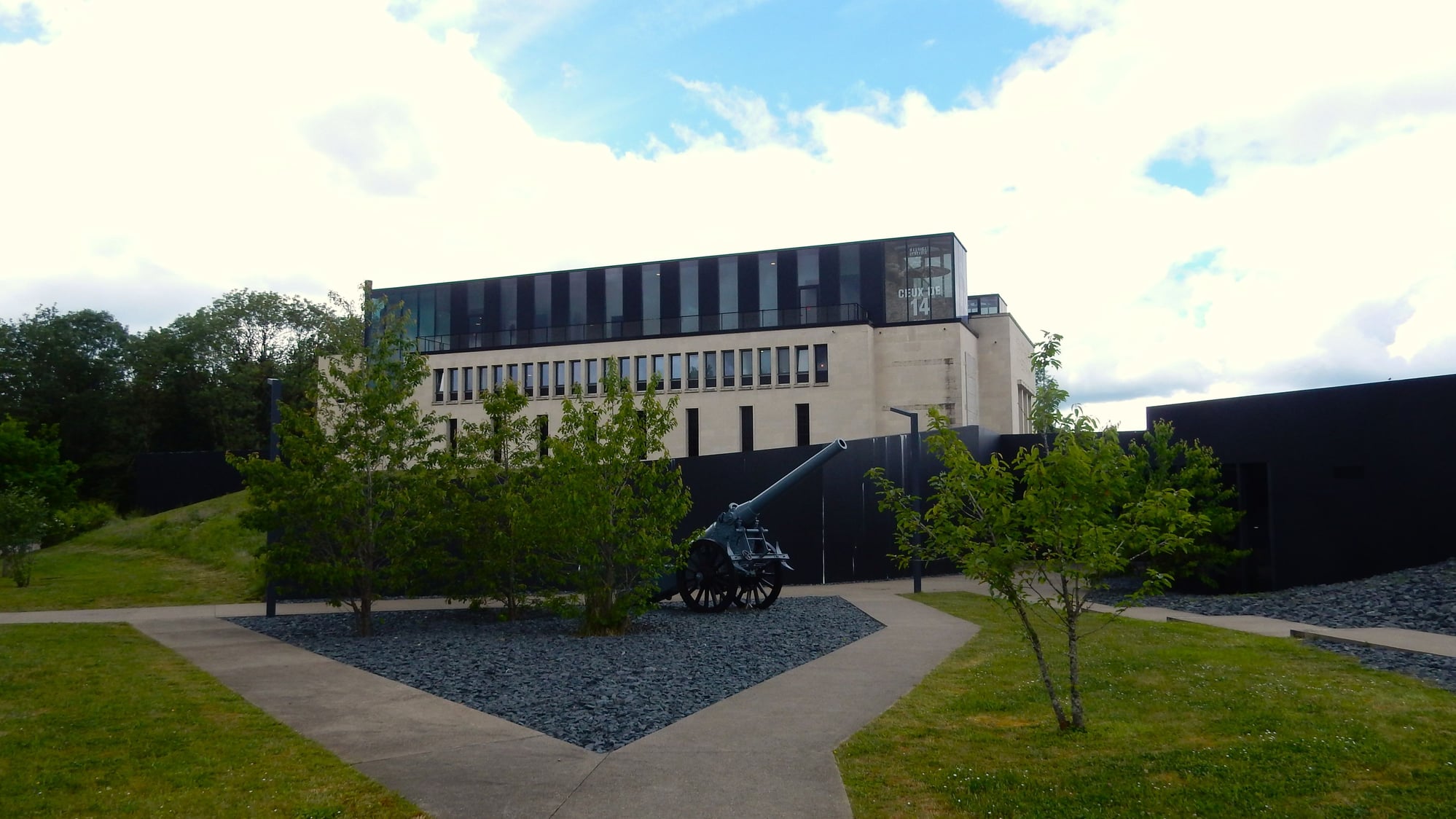
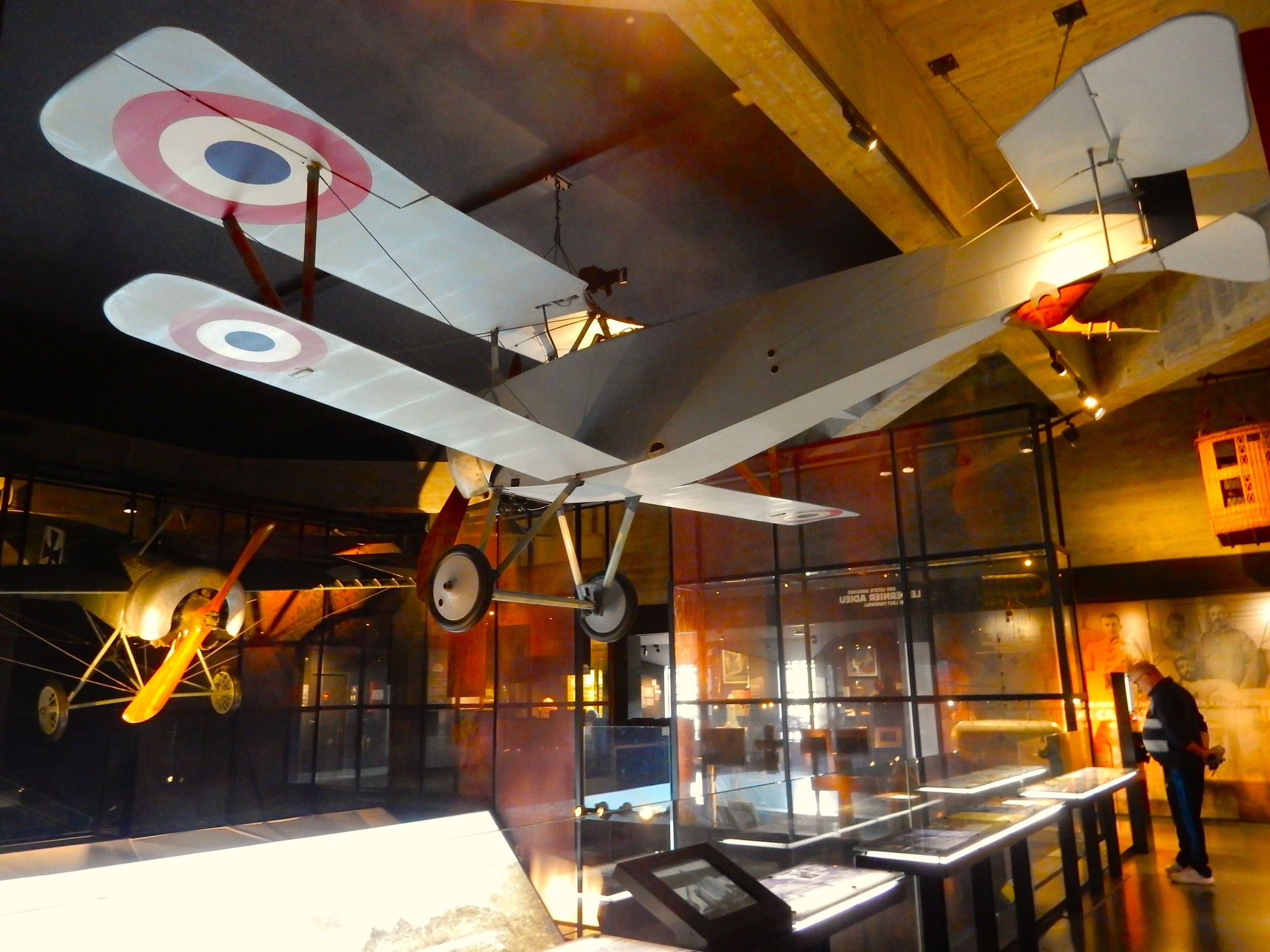
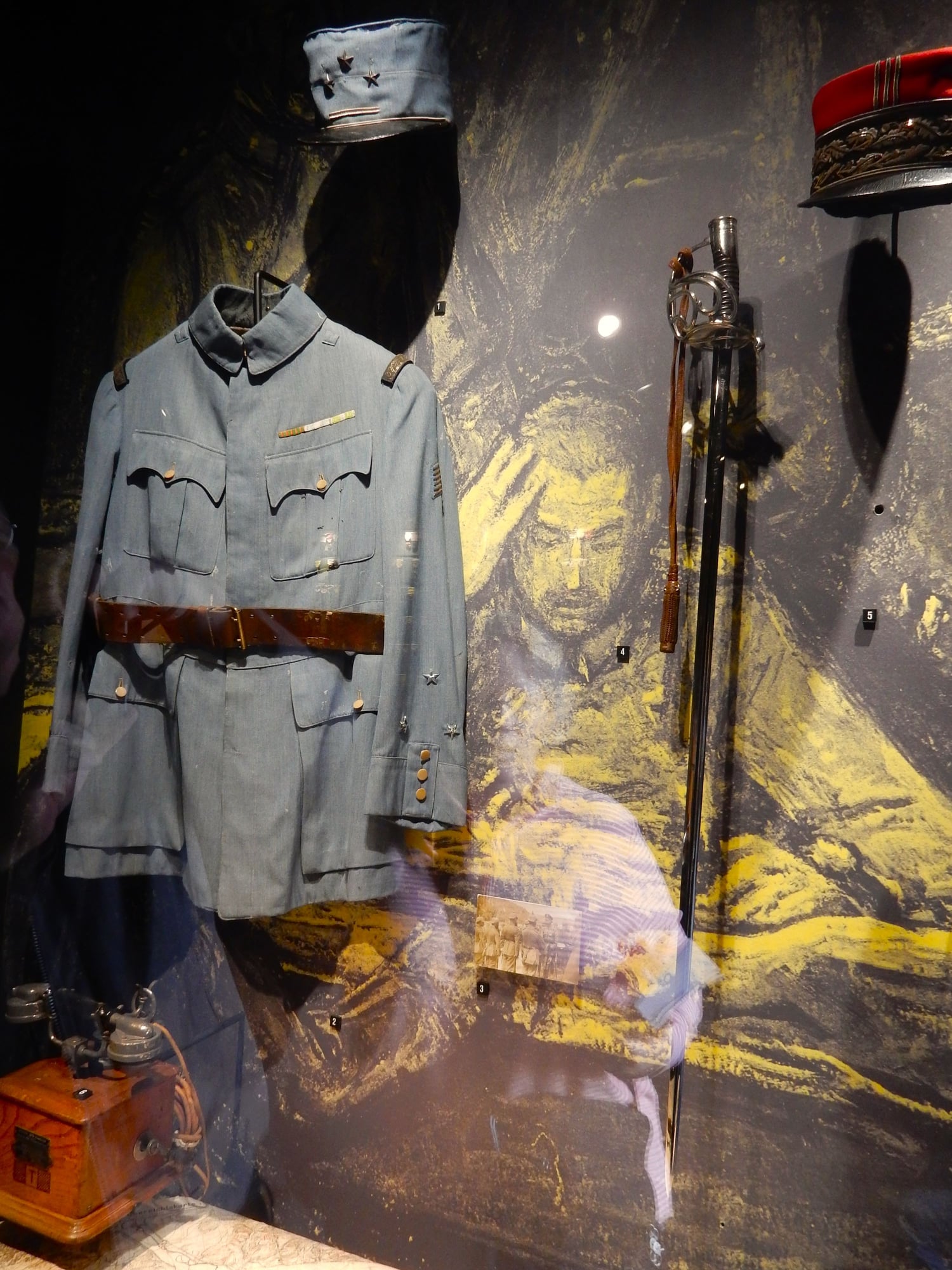
If you are doing the Verdun battlefield, I would skip the admission to the interior of the Douamont Ossuary, unless you feel its worth it just to climb the tower. The cemetery surrounding, however, is worth a stop.


Note that the graves of the Muslim troops are at an angle to the rest of the cemetery, because, in keeping with their religious tradition, they face to the East.
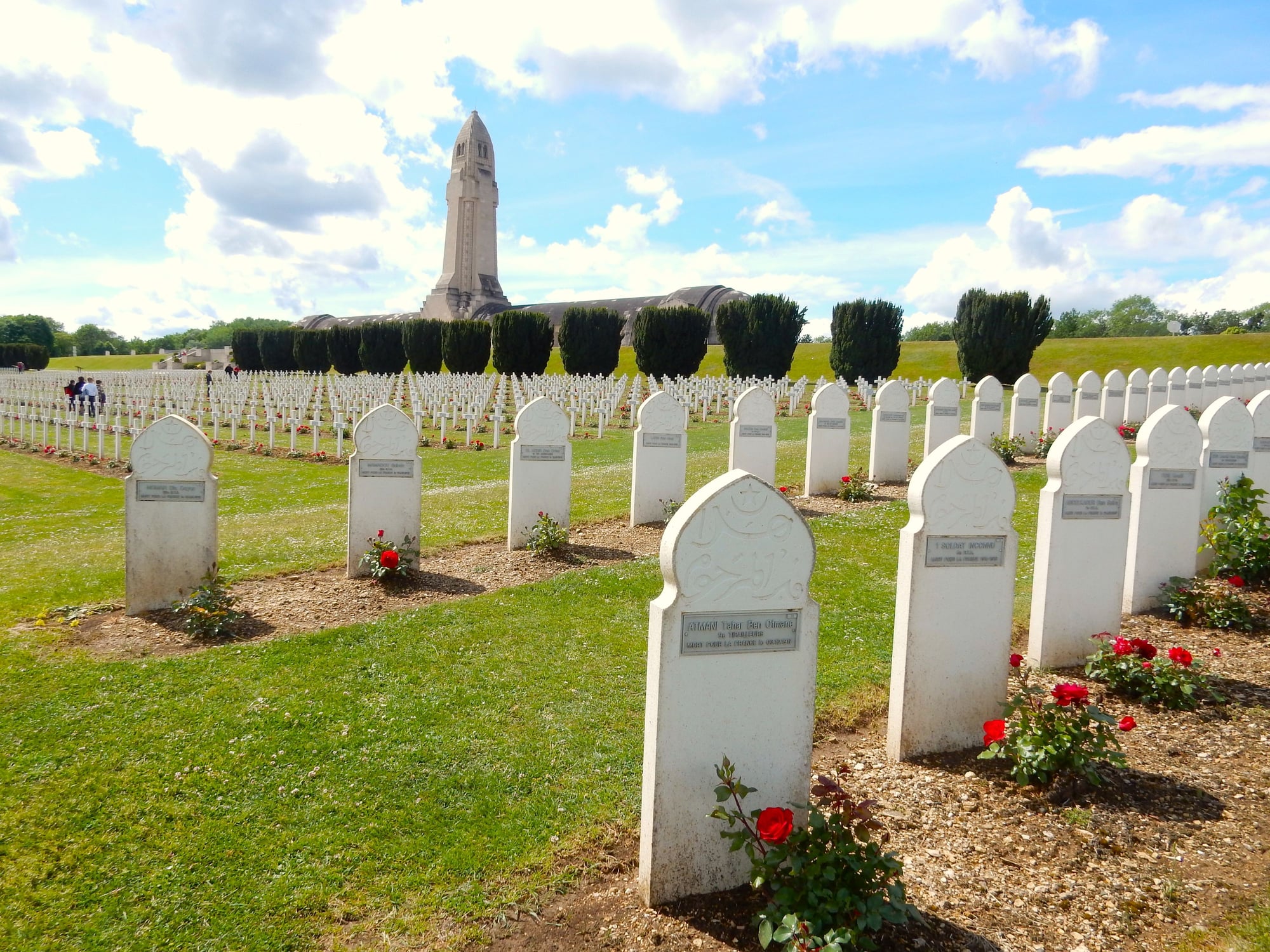
Fort Douamont was built prior to the war, but was largely stripped of its armaments by the French who felt it was obsolete as an artillery position, and was only manned by a skeleton crew when the Germans started their Verdun offensive in February of 1916. Whatever it lacked as a base of fire, it was a great troop shelter and the French spent months, and thousands of lives, taking this ground back.

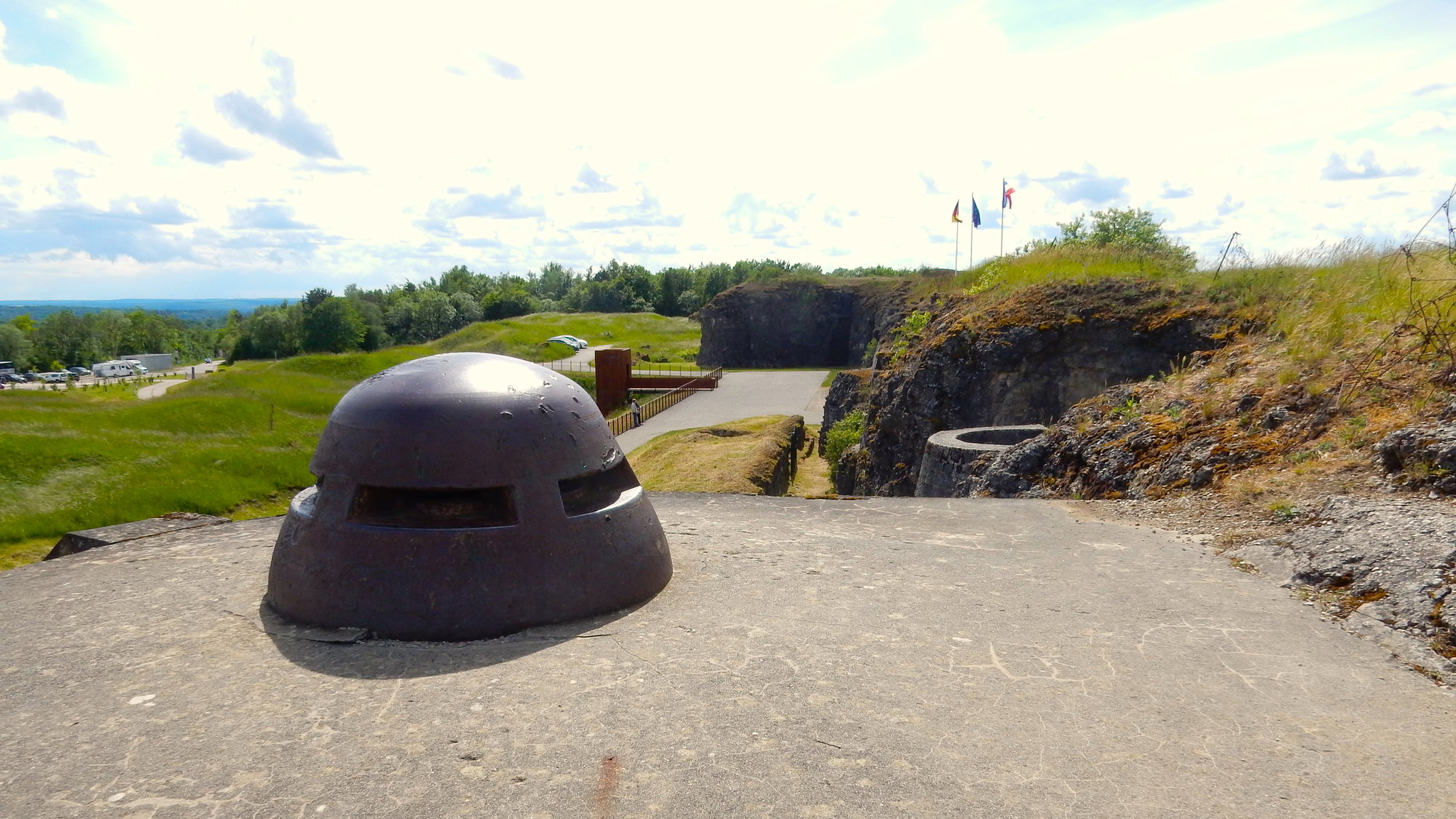
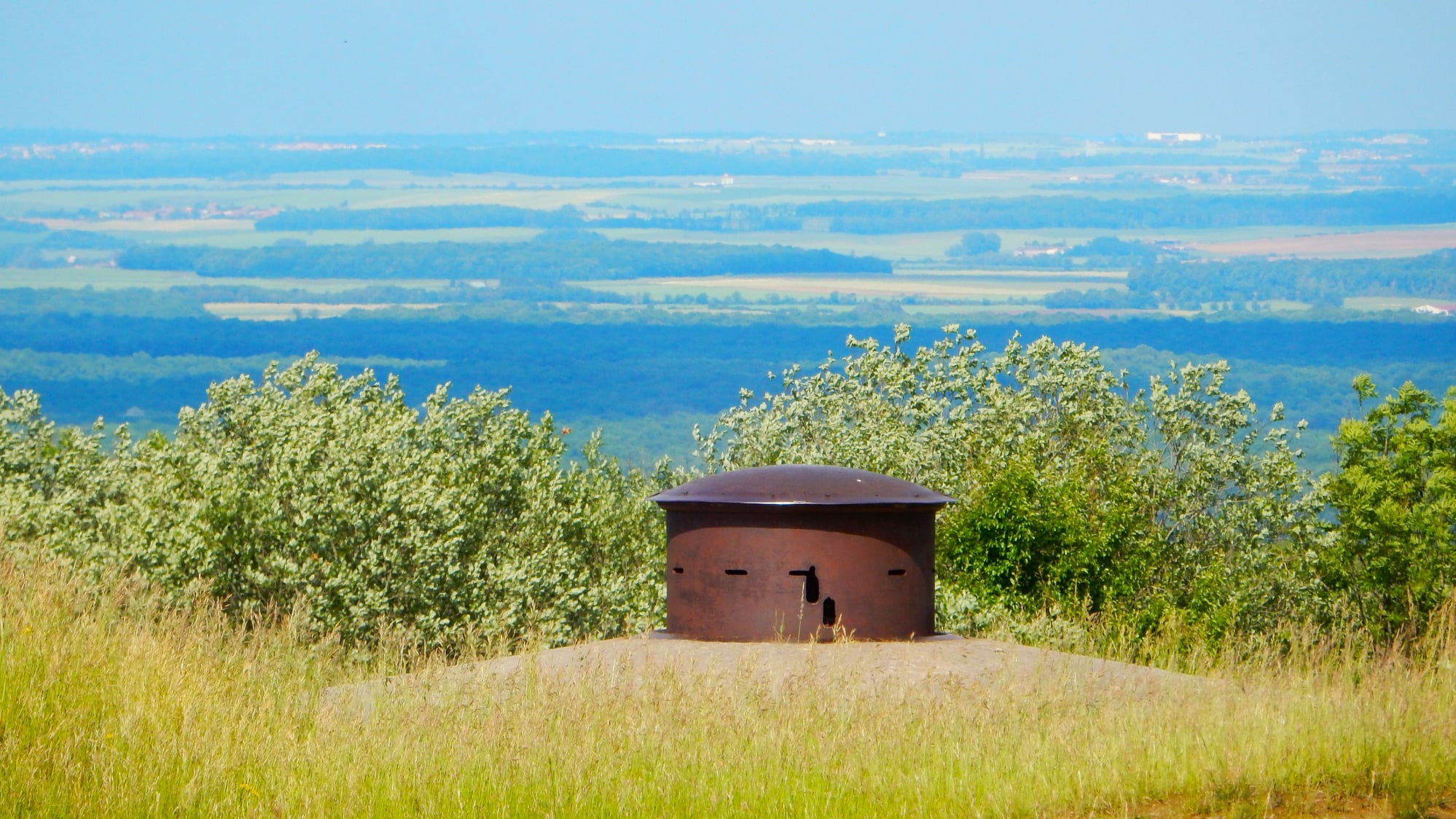
We moved on from Reims and Champagne to the battlefields of Verdun. After grabbing lunch in town, and getting some gas (23 litres for 46 euros), we proceeded to the Verdun Memorial, a fantastic museum located along a road with many battle sites. This may be the best battlefield museum I have ever visited. It has a ton of artifacts, ranging from large (artillery and aircraft) to small (everything in a soldier's standard issue kit, right down to his underwear). The uniform display was ingenious, as they displayed the coat, headgear and other items in conventional fashion, but then, under that display, they would have a bunch of drawers that you could open, displaying other items in the uniform or standard issue equipment. The story boards and films provided an overview of the war and how the 1916 battle of Verdun fit into the big picture, but then went into great detail on the battle. We spent an hour and a half here and could have spent more.
The next stop was the Douamont Ossuary and the adjoining French cemetery. Paying the 6 euro admission to go inside the Ossuary was a waste of money, while the cemetery was worth a stop. The final site along the road was Fort Douamont, a large subterranean gun battery. Here, there is an admission charge to get inside, but no charge to climb the exterior. Again, as with the Ossuary, I felt like the interior was not worth paying to see, but the climb to the top on the exterior was worth the trouble, showing the gun emplacements, shell craters, and the commanding view of the surrounding countryside. We returned to town, checked in to our hotel, then had dinner just down the street at a local favorite where the menu was written on a chalkboard and the place ended up being packed by 8:00.
Verdun has some sites in town, including a cathedral that survived the war and the underground citadel that served as a hub for troops moving to or back from the front, but we did not venture much beyond our initial look around the riverfront area.




The Memorial de Verdun is probably the best museum dedicated to a specific battle that I've seen anywhere.



If you are doing the Verdun battlefield, I would skip the admission to the interior of the Douamont Ossuary, unless you feel its worth it just to climb the tower. The cemetery surrounding, however, is worth a stop.


Note that the graves of the Muslim troops are at an angle to the rest of the cemetery, because, in keeping with their religious tradition, they face to the East.

Fort Douamont was built prior to the war, but was largely stripped of its armaments by the French who felt it was obsolete as an artillery position, and was only manned by a skeleton crew when the Germans started their Verdun offensive in February of 1916. Whatever it lacked as a base of fire, it was a great troop shelter and the French spent months, and thousands of lives, taking this ground back.



#31
The thing about the tower at the Ossuary... From the top, you get a panoramic view with a map indicating the location of all the area battles... so much fighting so incredibly close together and the same terrain changing hands multiple times. It really hit home the mutual insanity that occurred in this area. Also, things may have changed since we were there, but there was a room of photographs taken of the area after the war ended. They could easily be mistaken for photos taken after a nuclear war.
The view of the cemetery from the top of the lantern is sobering:
https://www.travelfranceonline.com/w...f-the-Dead.jpg
But the amount of bones under the ossuary building that are visible from the outside is close to incomprehensible. 16,000 identified remains in the cemetery. Bones of 130,000 unidentified soldiers (on both sides) under the ossuary.
The view of the cemetery from the top of the lantern is sobering:
https://www.travelfranceonline.com/w...f-the-Dead.jpg
But the amount of bones under the ossuary building that are visible from the outside is close to incomprehensible. 16,000 identified remains in the cemetery. Bones of 130,000 unidentified soldiers (on both sides) under the ossuary.
#32
Original Poster
Join Date: Jul 2005
Posts: 1,490
Likes: 0
Received 0 Likes
on
0 Posts
I took a little time to go back and read some of my posts and was appalled at the number of typos that I failed to catch. Most of the daily log was composed as we were travelling on a tablet, without the benefit of a real keyboard, and with a very intrusive spell check program that makes a hash out of much of what you are typing. I've been reviewing that text and making some revisions when I post here, but I'm obviously not reviewing closely enough. I'll try to do better.
I also notice that I completely forgot to mention Pointe du Hoc, even though I included a picture. We actually spent a pretty fair amount of time there, and I would be remiss if I did not point out what an important stop it is for anyone doing the American sectors of the D-Day invasion sites. I also wanted to take a moment to commend our guide, Magali, for tailoring the tour to our needs, which most of the private guides do. Besides asking us what we were interested in when setting up the tour (and Pointe du Hoc was one of our points of emphasis, since Col. Rudder was a Texas A&M graduate [so am I], and future school president), she also knew where to park and enter Pointe du Hoc and the American cemetery so as to minimize the walking for my sister. Something you might want to keep in mind when deciding between the group mini-bus tours and a private guide.
Also, thanks for the comments and questions.
I also notice that I completely forgot to mention Pointe du Hoc, even though I included a picture. We actually spent a pretty fair amount of time there, and I would be remiss if I did not point out what an important stop it is for anyone doing the American sectors of the D-Day invasion sites. I also wanted to take a moment to commend our guide, Magali, for tailoring the tour to our needs, which most of the private guides do. Besides asking us what we were interested in when setting up the tour (and Pointe du Hoc was one of our points of emphasis, since Col. Rudder was a Texas A&M graduate [so am I], and future school president), she also knew where to park and enter Pointe du Hoc and the American cemetery so as to minimize the walking for my sister. Something you might want to keep in mind when deciding between the group mini-bus tours and a private guide.
Also, thanks for the comments and questions.
#33
Original Poster
Join Date: Jul 2005
Posts: 1,490
Likes: 0
Received 0 Likes
on
0 Posts
Wednesday, May 25
The trip from Verdun to Colmar featured 3 stops.
First, we went to the St. Mihiel American Cemetery, which was established to handle the dead from the September 1918 offensive to eliminate the St. Mihiel salient, which protruded out from the rest of the western front south of Verdun. General Pershing didn't want American troops fighting under foreign command, so the Americans mostly stayed out of the fighting until Pershing and his army were ready to participate in this offensive in September, 1918. The cemetery was in pristine condition, and only missing the sea view to match that at Omaha Beach. We talked to the young American in charge and he told us that he got this job by applying online, when looking for an overseas job with the federal government, and lives in a house next to the cemetery that comes with the job. He also said that the American philosophy on war graves was to have fewer locations so that they could be more easily maintained, whereas when you travel through France you will see some British cemeteries with as few as 20 graves. St. Mihiel has 4,100 graves, and a monument to the unknown and missing. One Medal of Honor winner is buried here. They get very few visitors here, and only a fraction of those who do visit are American. Although the entrance doesn't look all that imposing (you park right in front of the gates, and just off the road) It's really a moving site once you get on the grounds.
Next, we drove about 20 minutes to the Butte de Montsec, where the US had constructed a monument to the St. Mihiel offensive on this commanding height that the Germans had used to great effect during their 4 year occupation of the area. The monument has arrows indicating the direction and distance to various points on the battlefield and to the St. Milhiel cemetery, along with a large relief map showing the battlefield. You drive up to the parking lot and only have a short walk up a few steps from there to the top of the monument.
Finally, we drove the scenic route (rather than the route that goes through a tunnel) through the Vosges Mountains to the town of Kayserberg, a picture postcard town along the Alsatian Route du Vin. This little town looked like it would have been a lovely place to spend a couple of nights if we had decided to base somewhere other than Colmar. After spending most of the afternoon in Kayserberg, we headed into Colmar, where we had to make a couple of attempts before we wound our way through the warren of one way and pedestrian only streets in order to actually get to our apartment in the center of town at 8 Rue des Augustins. Getting in late in the afternoon, when the old town was busy with daytrippers, proved a lot harder than getting out when we left a few days later.
The St. Mihiel American Cemetery is not in St. Mihiel, but rather, is named after the offensive in which most of its occupants were killed.




You can see the Butte de Montsec from miles away.
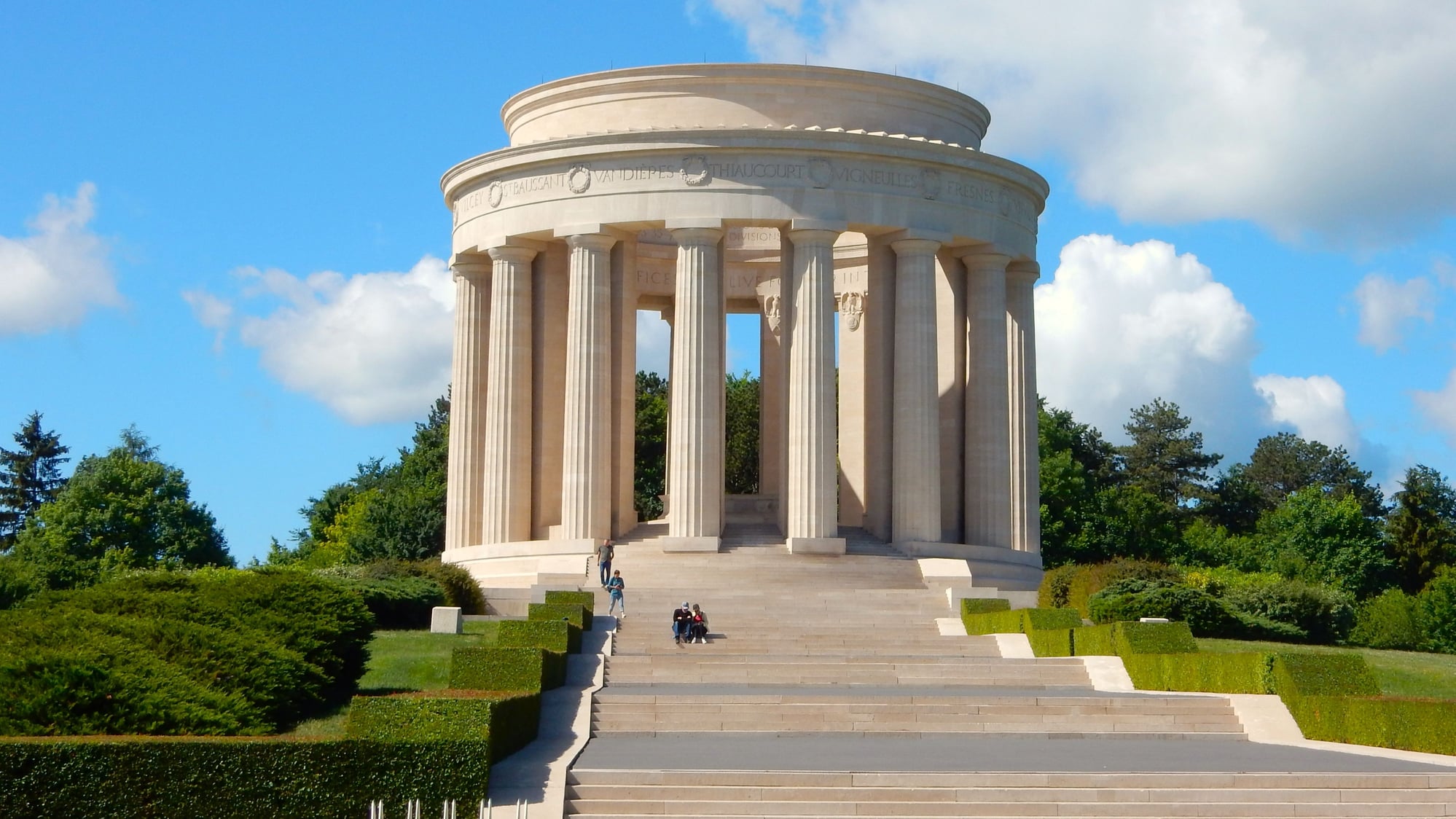



Kayserberg is a beautiful town on the Route du Vin, and was the home of Albert Schweitzer.
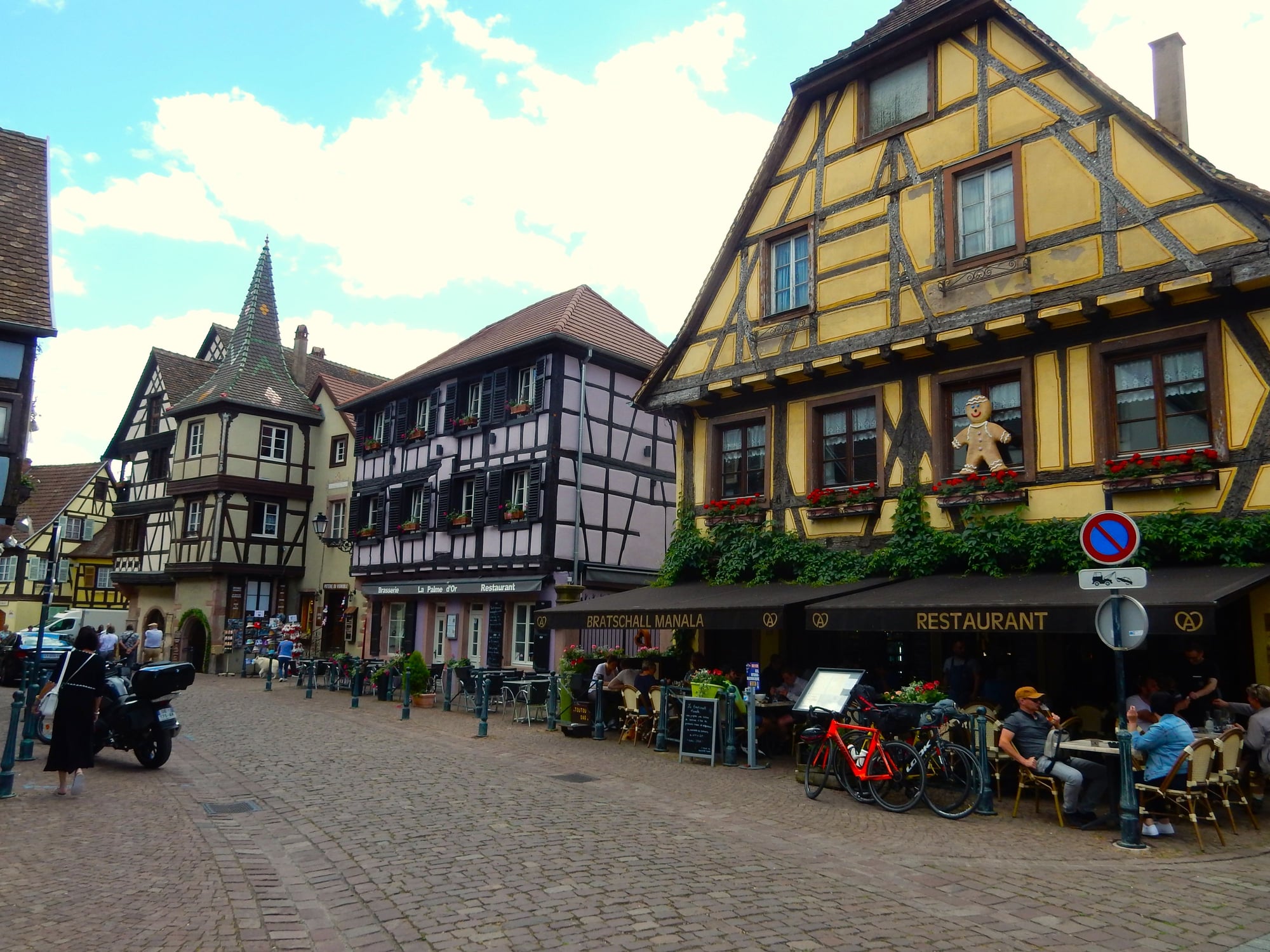
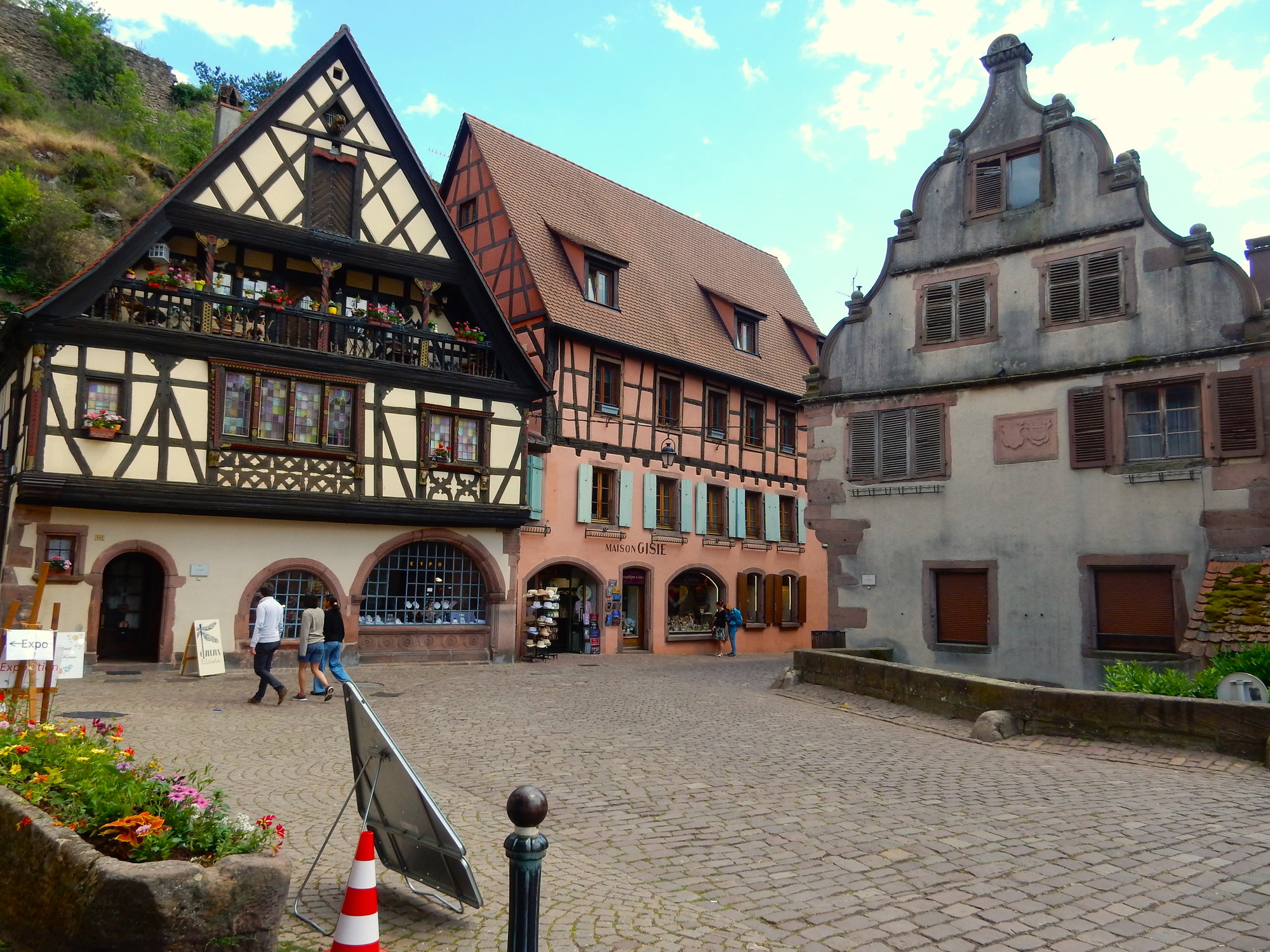

The trip from Verdun to Colmar featured 3 stops.
First, we went to the St. Mihiel American Cemetery, which was established to handle the dead from the September 1918 offensive to eliminate the St. Mihiel salient, which protruded out from the rest of the western front south of Verdun. General Pershing didn't want American troops fighting under foreign command, so the Americans mostly stayed out of the fighting until Pershing and his army were ready to participate in this offensive in September, 1918. The cemetery was in pristine condition, and only missing the sea view to match that at Omaha Beach. We talked to the young American in charge and he told us that he got this job by applying online, when looking for an overseas job with the federal government, and lives in a house next to the cemetery that comes with the job. He also said that the American philosophy on war graves was to have fewer locations so that they could be more easily maintained, whereas when you travel through France you will see some British cemeteries with as few as 20 graves. St. Mihiel has 4,100 graves, and a monument to the unknown and missing. One Medal of Honor winner is buried here. They get very few visitors here, and only a fraction of those who do visit are American. Although the entrance doesn't look all that imposing (you park right in front of the gates, and just off the road) It's really a moving site once you get on the grounds.
Next, we drove about 20 minutes to the Butte de Montsec, where the US had constructed a monument to the St. Mihiel offensive on this commanding height that the Germans had used to great effect during their 4 year occupation of the area. The monument has arrows indicating the direction and distance to various points on the battlefield and to the St. Milhiel cemetery, along with a large relief map showing the battlefield. You drive up to the parking lot and only have a short walk up a few steps from there to the top of the monument.
Finally, we drove the scenic route (rather than the route that goes through a tunnel) through the Vosges Mountains to the town of Kayserberg, a picture postcard town along the Alsatian Route du Vin. This little town looked like it would have been a lovely place to spend a couple of nights if we had decided to base somewhere other than Colmar. After spending most of the afternoon in Kayserberg, we headed into Colmar, where we had to make a couple of attempts before we wound our way through the warren of one way and pedestrian only streets in order to actually get to our apartment in the center of town at 8 Rue des Augustins. Getting in late in the afternoon, when the old town was busy with daytrippers, proved a lot harder than getting out when we left a few days later.
The St. Mihiel American Cemetery is not in St. Mihiel, but rather, is named after the offensive in which most of its occupants were killed.




You can see the Butte de Montsec from miles away.




Kayserberg is a beautiful town on the Route du Vin, and was the home of Albert Schweitzer.



Last edited by twk; Jun 9th, 2022 at 12:58 PM.
#34
Original Poster
Join Date: Jul 2005
Posts: 1,490
Likes: 0
Received 0 Likes
on
0 Posts
Thursday, May 26
Today was overcast, but fairly warm, so it was a good day for seeing Colmar. Our apartment is so centrally located that once you walk half a block, it’s like you have entered a theme park. With the Ascension Day holiday, which always occurs on a Thursday, and becomes a four day weekend for many (Friday isn’t a holiday, but the French try to take it off, as well, to bridge the gap to the weekend, which is why they refer to this as “Le Pont,” meaning “The Bridge”), the town center was packed with tourists. There are a couple museums that people check out, but people mostly come to Colmar for the pretty setting and the food. We did see the Unterlinden Museum, which has the Issenheim altar piece as the highlight of its collection -- this was our only real art museum stop on the entire trip. After a nice lunch of traditional local food, we stopped by a delicacies shop and picked up Munster cheese and some kind of meat pie (think it was a mix of hamburger or some other ground meat and foie gras) which was delicious for supper.
Friday, May 27
We had intended to go check out a couple of more towns on the Route des Vins, but, my sister was not feeling up to it. I considered going solo, but the end of the trip fatigue and need to get some chores done (including some laundry) convinced me to stay in Colmar, have some more good food, and just poke around the old town some more.
Saturday, May 28
Today, we began the trip home, but first, we would stop to get Covid tests and see one more old town. We made the one hour drive from Colmar to Strasbourg, filling up with gas one final time (15 litres for 31 euros), and arriving at the Europcar rental office across the street from the railway station about 9:30 a.m.
Rather than scrambling to get Covid tests done upon arrival in Paris, I had looked online and set up appointments to do Covid tests at a pharmacy a few blocks from the station at 10:30 a.m. It took me an hour on Thursday to do this, between the searching and completing the online forms, and I would much rather have been doing some sightseeing Saturday morning, but I was anxious to get a test result so that I could send it to American Airlines and get everything lined up for the flight home. As I type this, I see in the news that none of you that are reading this will have to bother with the pointless exercise of testing vaccinated people with no symptoms (as long as you aren't flying before Sunday), but the actual test and getting the results was not a big chore. The pharmacy told us they would email the results, but that we could come back in 20 minutes and get the results printed out. We waited a little while at Starbucks (more for the internet than the coffee) and, although I got an email from the Doctolib website which probably would have had the results, had I jumped through all the hoops (two factor authentication, just for starters), instead, we went back to the pharmacy and got our paper test results. We took these back to Starbucks, uploaded photos, and completed the CDC form through the American Airlines apps, and were given the “complete” sign, meaning we were ready to fly.
Breathing a huge sigh of relief, we lined up an Uber to take us to the cathedral, which was going to be closed for lunch by the time that we got over there, but the plan was to have lunch then check out the cathedral. Lunch pretty much went to plan, but, when 12:45 rolled around, and the cathedral was supposed to reopen, there was a fairly long line to get in. Even when it finally started moving a bit, progress was slow, which seemed strange for a cite with no admission. In retrospect, I think perhaps this line was for the tower or something. But, at the time, it was enough to put us off from going inside to see the interior, with the sheer size of the exterior being impressive enough. We walked over to a side street on the northeast side of the square, and took an Uber back to the station, taking a different route around the north side of the old town, which was a lot more attractive. When I get too old to travel independently, I might come back to Strasbourg on one of those Rhine River cruises.
Our TGV which would take us directly to CDG left at 2:59 p.m., and arrived at 5:03 p.m. We would spend our final night at the airport Sheraton, which sits almost in the middle of Terminal 2. While I suppose some would have opted for a final night in Paris, with a not-so-early 11:25 a.m. flight out on Sunday morning, I like the stress free aspect of being at the airport. As it turned out, events elsewhere probably made this a smart move as the February invasion of Ukraine resulted in the Champions League final being moved from St. Petersburg to Paris. With tens of thousands of Liverpool and Real Madrid fans taking over the town, we were happy to be away from the action.
Sunday, May 29
While I managed to cut myself on the heavy door of my hotel room closing on my forearm, our return flight day was, otherwise, uneventful. We left the hotel just before 9:00 a.m., and although we move somewhat slowly, security moved even slower, and we only arrived at the gate 10 minutes before boarding was scheduled to begin at 10:35 a.m. Our flight was delayed 25 minutes, so we ended up waiting a while anyway. The flight back was fine for us, although I felt sorry for the folks on the row behind us who had to make the whole flight without their entertainment screens working (and with the Wifi largely being ineffective as too many people were trying to get on). I was not interested in either of the meal selections offered, so I bought a sandwich and some chips before boarding the aircraft. Once we got back to DFW, we stopped for some Tex-Mex in Southlake before making the 90 minute drive back to Wichita Falls.
Colmar's old town doesn't have a lot of major history sites, but it is very popular with tourists


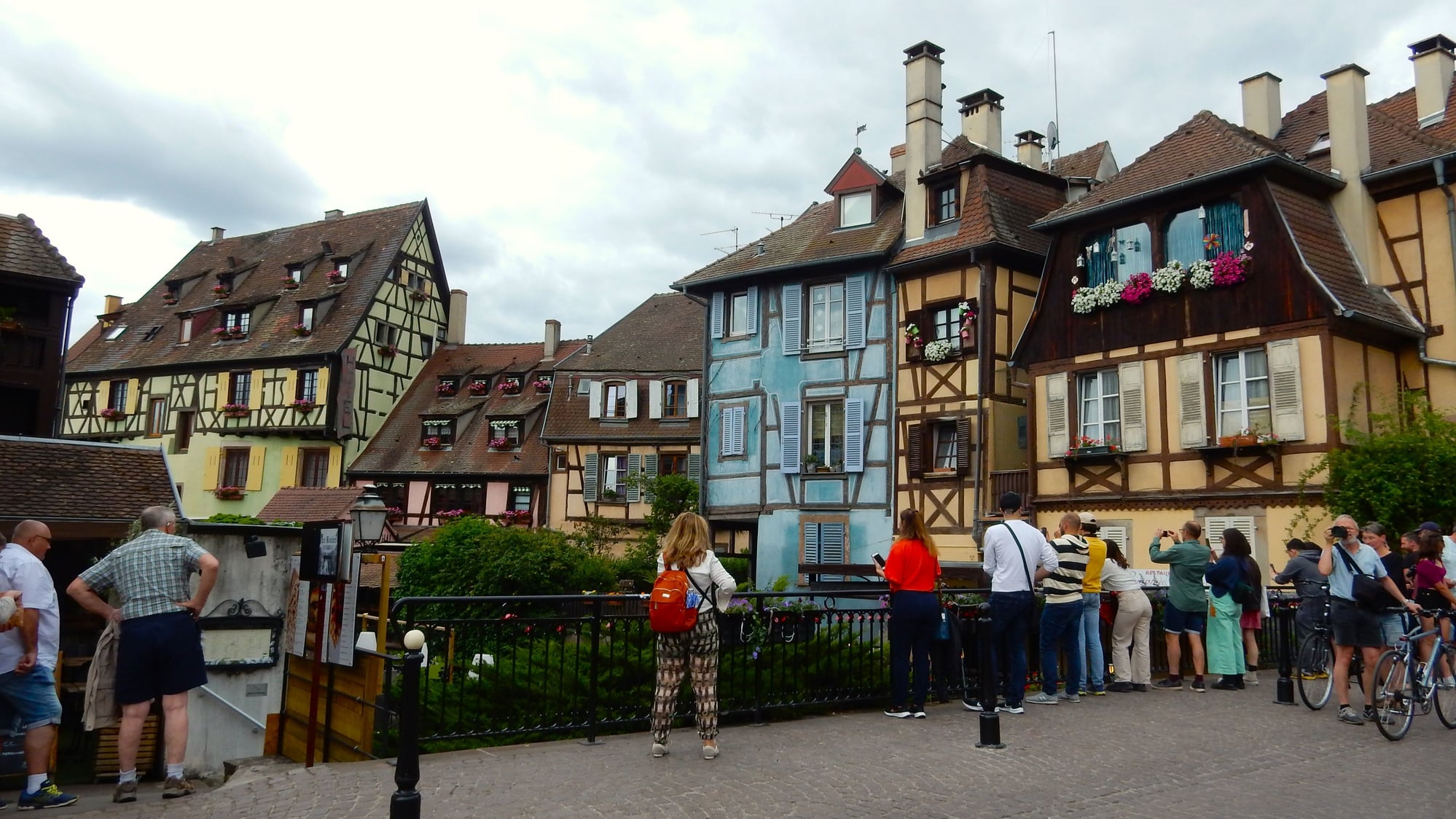


There is a museum dedicated to the works of sculptor Auguste Bartholdi (the Statue of Liberty being his best known work), and a number of his works appear throughout the town.
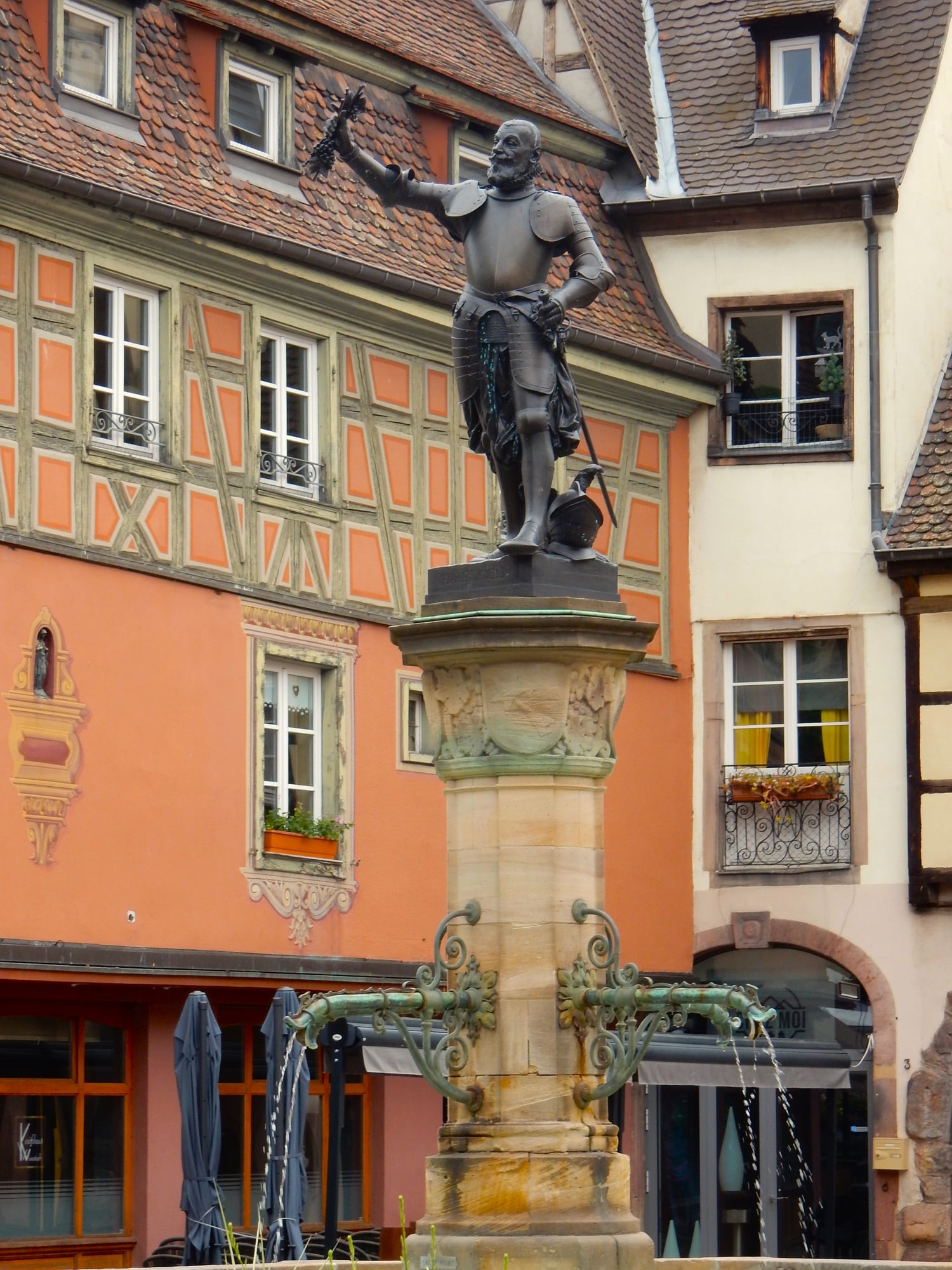
We didn't get to spend as much time as I would have liked thanks to wasting time with Covid testing.
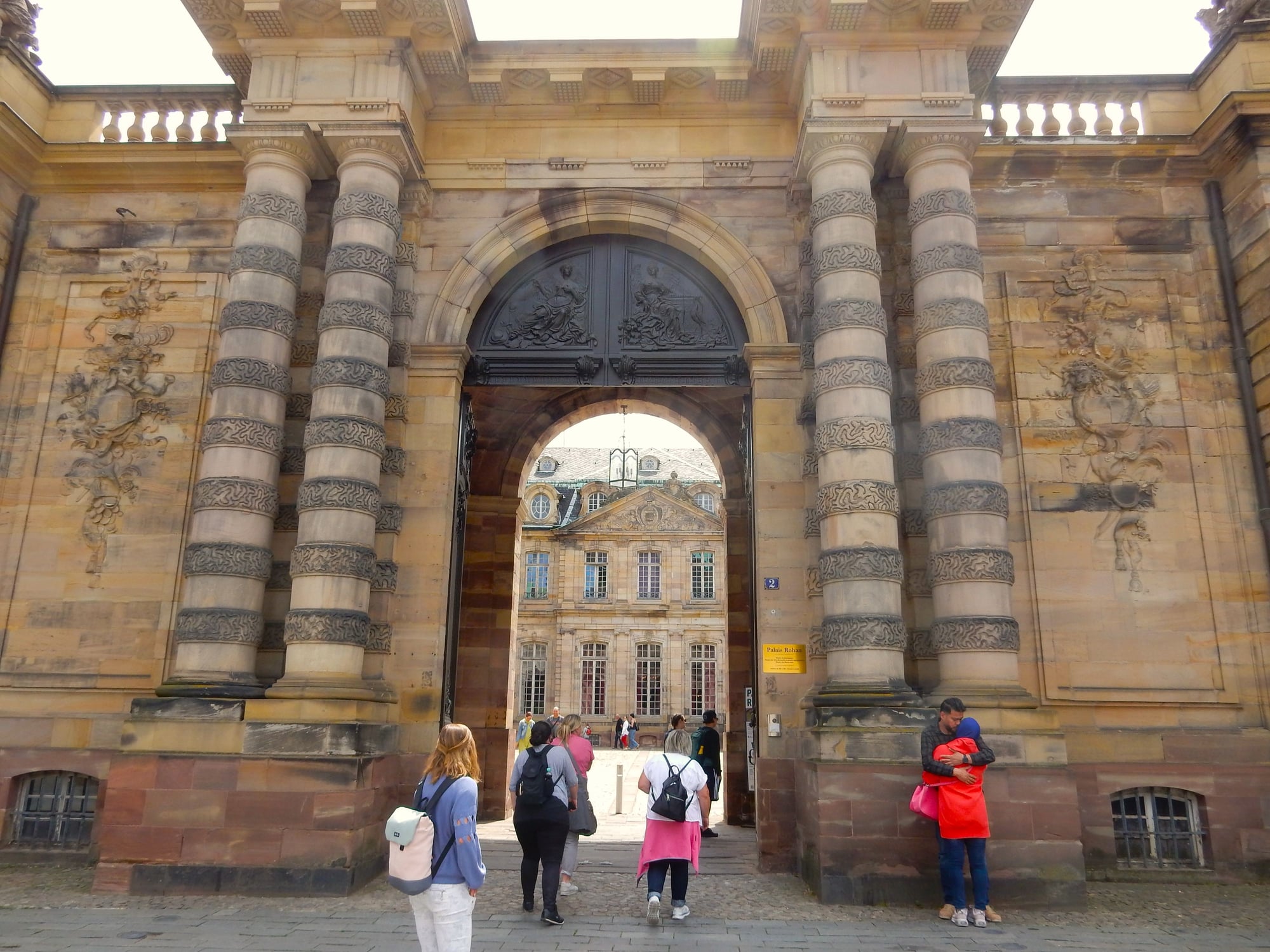

Today was overcast, but fairly warm, so it was a good day for seeing Colmar. Our apartment is so centrally located that once you walk half a block, it’s like you have entered a theme park. With the Ascension Day holiday, which always occurs on a Thursday, and becomes a four day weekend for many (Friday isn’t a holiday, but the French try to take it off, as well, to bridge the gap to the weekend, which is why they refer to this as “Le Pont,” meaning “The Bridge”), the town center was packed with tourists. There are a couple museums that people check out, but people mostly come to Colmar for the pretty setting and the food. We did see the Unterlinden Museum, which has the Issenheim altar piece as the highlight of its collection -- this was our only real art museum stop on the entire trip. After a nice lunch of traditional local food, we stopped by a delicacies shop and picked up Munster cheese and some kind of meat pie (think it was a mix of hamburger or some other ground meat and foie gras) which was delicious for supper.
Friday, May 27
We had intended to go check out a couple of more towns on the Route des Vins, but, my sister was not feeling up to it. I considered going solo, but the end of the trip fatigue and need to get some chores done (including some laundry) convinced me to stay in Colmar, have some more good food, and just poke around the old town some more.
Saturday, May 28
Today, we began the trip home, but first, we would stop to get Covid tests and see one more old town. We made the one hour drive from Colmar to Strasbourg, filling up with gas one final time (15 litres for 31 euros), and arriving at the Europcar rental office across the street from the railway station about 9:30 a.m.
Rather than scrambling to get Covid tests done upon arrival in Paris, I had looked online and set up appointments to do Covid tests at a pharmacy a few blocks from the station at 10:30 a.m. It took me an hour on Thursday to do this, between the searching and completing the online forms, and I would much rather have been doing some sightseeing Saturday morning, but I was anxious to get a test result so that I could send it to American Airlines and get everything lined up for the flight home. As I type this, I see in the news that none of you that are reading this will have to bother with the pointless exercise of testing vaccinated people with no symptoms (as long as you aren't flying before Sunday), but the actual test and getting the results was not a big chore. The pharmacy told us they would email the results, but that we could come back in 20 minutes and get the results printed out. We waited a little while at Starbucks (more for the internet than the coffee) and, although I got an email from the Doctolib website which probably would have had the results, had I jumped through all the hoops (two factor authentication, just for starters), instead, we went back to the pharmacy and got our paper test results. We took these back to Starbucks, uploaded photos, and completed the CDC form through the American Airlines apps, and were given the “complete” sign, meaning we were ready to fly.
Breathing a huge sigh of relief, we lined up an Uber to take us to the cathedral, which was going to be closed for lunch by the time that we got over there, but the plan was to have lunch then check out the cathedral. Lunch pretty much went to plan, but, when 12:45 rolled around, and the cathedral was supposed to reopen, there was a fairly long line to get in. Even when it finally started moving a bit, progress was slow, which seemed strange for a cite with no admission. In retrospect, I think perhaps this line was for the tower or something. But, at the time, it was enough to put us off from going inside to see the interior, with the sheer size of the exterior being impressive enough. We walked over to a side street on the northeast side of the square, and took an Uber back to the station, taking a different route around the north side of the old town, which was a lot more attractive. When I get too old to travel independently, I might come back to Strasbourg on one of those Rhine River cruises.
Our TGV which would take us directly to CDG left at 2:59 p.m., and arrived at 5:03 p.m. We would spend our final night at the airport Sheraton, which sits almost in the middle of Terminal 2. While I suppose some would have opted for a final night in Paris, with a not-so-early 11:25 a.m. flight out on Sunday morning, I like the stress free aspect of being at the airport. As it turned out, events elsewhere probably made this a smart move as the February invasion of Ukraine resulted in the Champions League final being moved from St. Petersburg to Paris. With tens of thousands of Liverpool and Real Madrid fans taking over the town, we were happy to be away from the action.
Sunday, May 29
While I managed to cut myself on the heavy door of my hotel room closing on my forearm, our return flight day was, otherwise, uneventful. We left the hotel just before 9:00 a.m., and although we move somewhat slowly, security moved even slower, and we only arrived at the gate 10 minutes before boarding was scheduled to begin at 10:35 a.m. Our flight was delayed 25 minutes, so we ended up waiting a while anyway. The flight back was fine for us, although I felt sorry for the folks on the row behind us who had to make the whole flight without their entertainment screens working (and with the Wifi largely being ineffective as too many people were trying to get on). I was not interested in either of the meal selections offered, so I bought a sandwich and some chips before boarding the aircraft. Once we got back to DFW, we stopped for some Tex-Mex in Southlake before making the 90 minute drive back to Wichita Falls.
Colmar's old town doesn't have a lot of major history sites, but it is very popular with tourists





There is a museum dedicated to the works of sculptor Auguste Bartholdi (the Statue of Liberty being his best known work), and a number of his works appear throughout the town.

We didn't get to spend as much time as I would have liked thanks to wasting time with Covid testing.


Last edited by twk; Jun 10th, 2022 at 06:33 AM.
#35
Bravo for your report. The photos are excellent and the commentary is extremely pertinent, not too much, not too little. And (I know that I will annoy some people here, but, tant pis, it was such a relief to read a trip report that wasn't overloaded with photos of your meals with the attendant gushing commentary over each dish.
I have made photo reports about most of the places that you visited, and it would be completely annoying for me to "compete" with you, since your photos are so wonderful. However, since I overdosed on the Verdun Mémorial museum, having gone there just after it opened, I will nevertheless link my report about it:
Mémorial de Verdun / WW1 museum of the battle of Verdun | Any Port in a Storm (proboards.com)
And since you showed your appreciation military sites, let me show something that you missed in the Vosges, even though it generally darkens one's trip to this beautiful region, The Struthof Nazi death camp:
Natzwiller - Le Struthof concentration camp | Any Port in a Storm (proboards.com)
I have made photo reports about most of the places that you visited, and it would be completely annoying for me to "compete" with you, since your photos are so wonderful. However, since I overdosed on the Verdun Mémorial museum, having gone there just after it opened, I will nevertheless link my report about it:
Mémorial de Verdun / WW1 museum of the battle of Verdun | Any Port in a Storm (proboards.com)
And since you showed your appreciation military sites, let me show something that you missed in the Vosges, even though it generally darkens one's trip to this beautiful region, The Struthof Nazi death camp:
Natzwiller - Le Struthof concentration camp | Any Port in a Storm (proboards.com)
#36
Original Poster
Join Date: Jul 2005
Posts: 1,490
Likes: 0
Received 0 Likes
on
0 Posts
Bravo for your report. The photos are excellent and the commentary is extremely pertinent, not too much, not too little. And (I know that I will annoy some people here, but, tant pis, it was such a relief to read a trip report that wasn't overloaded with photos of your meals with the attendant gushing commentary over each dish.
I have made photo reports about most of the places that you visited, and it would be completely annoying for me to "compete" with you, since your photos are so wonderful. However, since I overdosed on the Verdun Mémorial museum, having gone there just after it opened, I will nevertheless link my report about it:
Mémorial de Verdun / WW1 museum of the battle of Verdun | Any Port in a Storm (proboards.com)
And since you showed your appreciation military sites, let me show something that you missed in the Vosges, even though it generally darkens one's trip to this beautiful region, The Struthof Nazi death camp:
Natzwiller - Le Struthof concentration camp | Any Port in a Storm (proboards.com)
I have made photo reports about most of the places that you visited, and it would be completely annoying for me to "compete" with you, since your photos are so wonderful. However, since I overdosed on the Verdun Mémorial museum, having gone there just after it opened, I will nevertheless link my report about it:
Mémorial de Verdun / WW1 museum of the battle of Verdun | Any Port in a Storm (proboards.com)
And since you showed your appreciation military sites, let me show something that you missed in the Vosges, even though it generally darkens one's trip to this beautiful region, The Struthof Nazi death camp:
Natzwiller - Le Struthof concentration camp | Any Port in a Storm (proboards.com)
I didn't even know about the concentration camp. That would have been an interesting stop. Thanks for posting.
#37
I’ve enjoyed your reporting and photos (even though I like meal photos too  especially strawberry tarts…)
especially strawberry tarts…)
My only experience of France has been 3 visits to Alsace (loved Strasbourg, Wissembourg, the villages south and the car museum in Mulhouse).
 especially strawberry tarts…)
especially strawberry tarts…) My only experience of France has been 3 visits to Alsace (loved Strasbourg, Wissembourg, the villages south and the car museum in Mulhouse).
#38
Original Poster
Join Date: Jul 2005
Posts: 1,490
Likes: 0
Received 0 Likes
on
0 Posts
I don't mind other folks posting about food, but you have to be a pretty good writer to make some of the longer descriptions interesting. And the ratio of food photos to sight seeing photos matters in this regard. But, to each his own. I just post trip reports as a way to payback the help that I get from reading about the experience of others, and while I don't build my trips around food, some folks do.
I guess that when it comes to food, I mostly focus on trying to sample some of the regional specialties, although my lack of adventure when it comes to food doesn't serve me well in this regard. However, I know there are others like me, and for any of those reading this, you can have a lot of fun in Europe without eating five course meals on a daily basis. Some of the most memorable food is the cheapest. Don't be intimidated by reports where every meal seems to be a gourmet meal. If that's not your travel style, don't let it put you off going to Europe.
I guess that when it comes to food, I mostly focus on trying to sample some of the regional specialties, although my lack of adventure when it comes to food doesn't serve me well in this regard. However, I know there are others like me, and for any of those reading this, you can have a lot of fun in Europe without eating five course meals on a daily basis. Some of the most memorable food is the cheapest. Don't be intimidated by reports where every meal seems to be a gourmet meal. If that's not your travel style, don't let it put you off going to Europe.
#39
twk, thank you for your comprehensive report on Normandy, the D-Day sites as well as Verdun and WWI cemetery, ossuaries,Champagne and a touch of Alsace.
We have visited the same places and I enjoyed returning to all of them with your extensive research included this time.
I hope in the future you can spend more time in Strasbourg and stay in one of the charming wine villages.We enjoyed our time there.
We have visited the same places and I enjoyed returning to all of them with your extensive research included this time.
I hope in the future you can spend more time in Strasbourg and stay in one of the charming wine villages.We enjoyed our time there.
#40
Original Poster
Join Date: Jul 2005
Posts: 1,490
Likes: 0
Received 0 Likes
on
0 Posts
Went back through this after it was all done and decided there were a few more photos I should have included.
First, a couple from Port-en-Bessin. The first one is taken along the waterfront, just steps from our Gite, the next, just around the corner, with the lock leading to the inner harbor on the left, and the fishing boats in the background. Most of the restaurants are along this strip, but there are other along a side street.

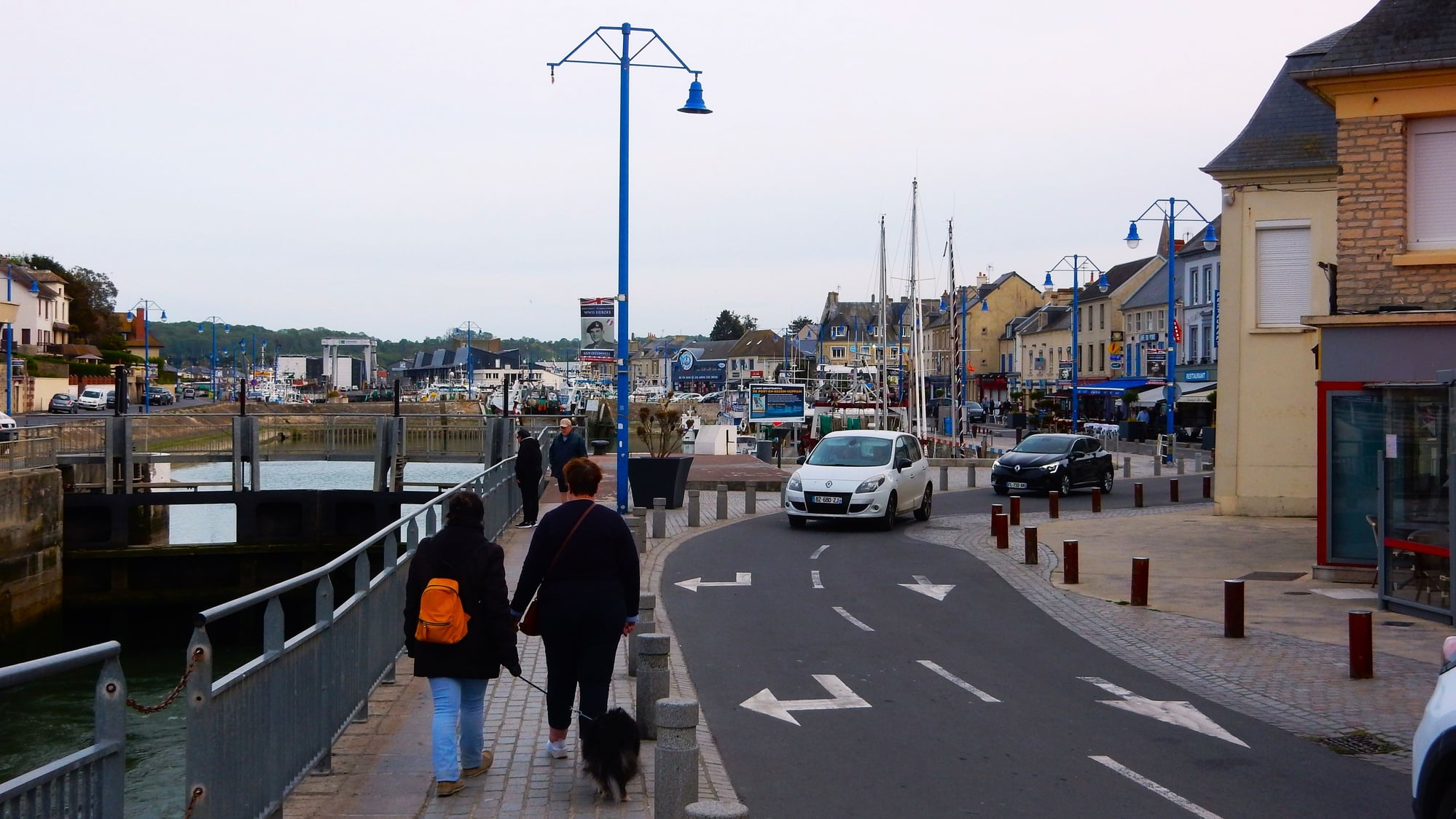
A couple more photos from Pointe du Hoc:
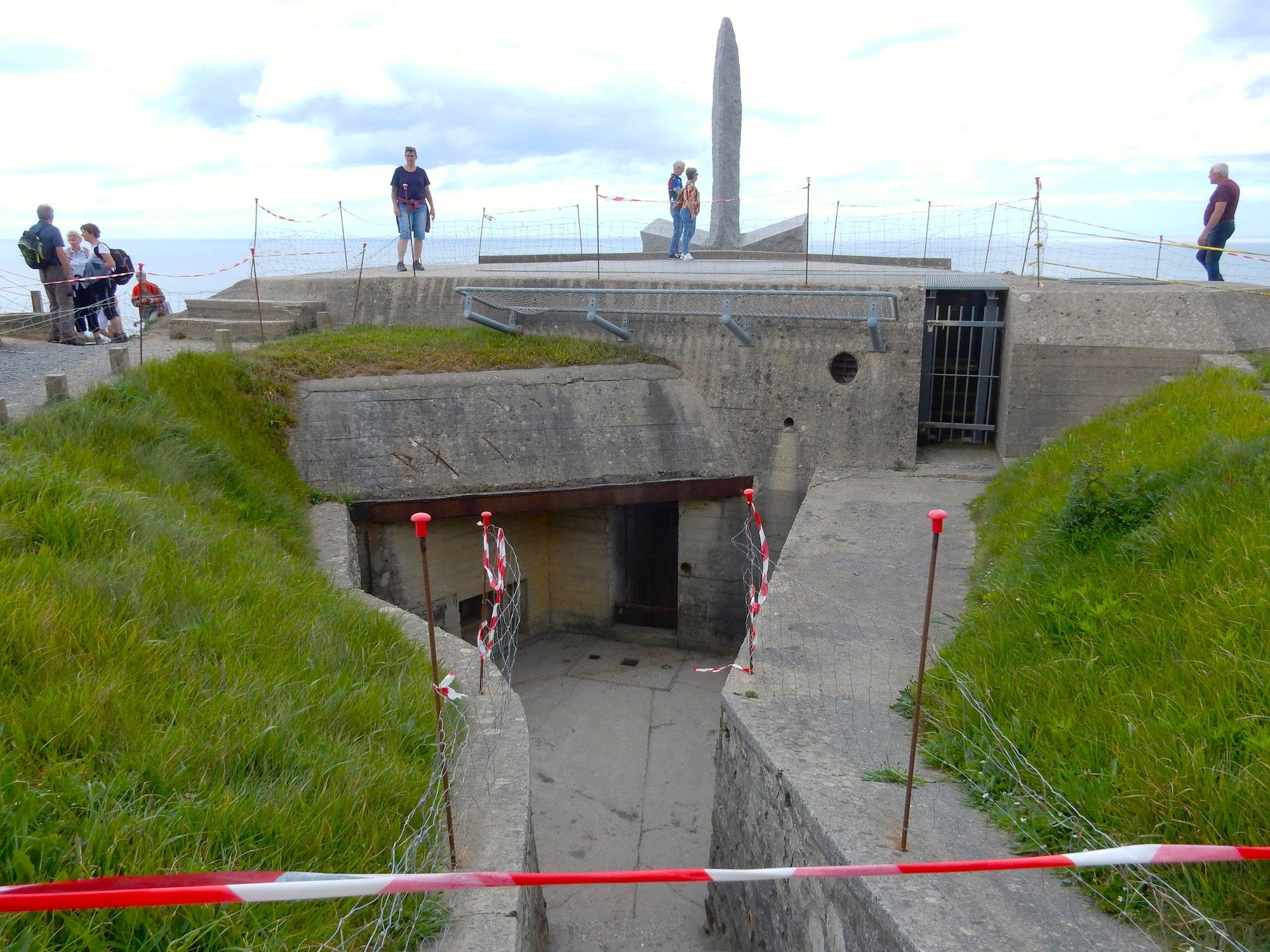

A couple more from Mont Saint-Michel, of the abbey exterior and interior:


And, the Chagall stained glass at Reims:
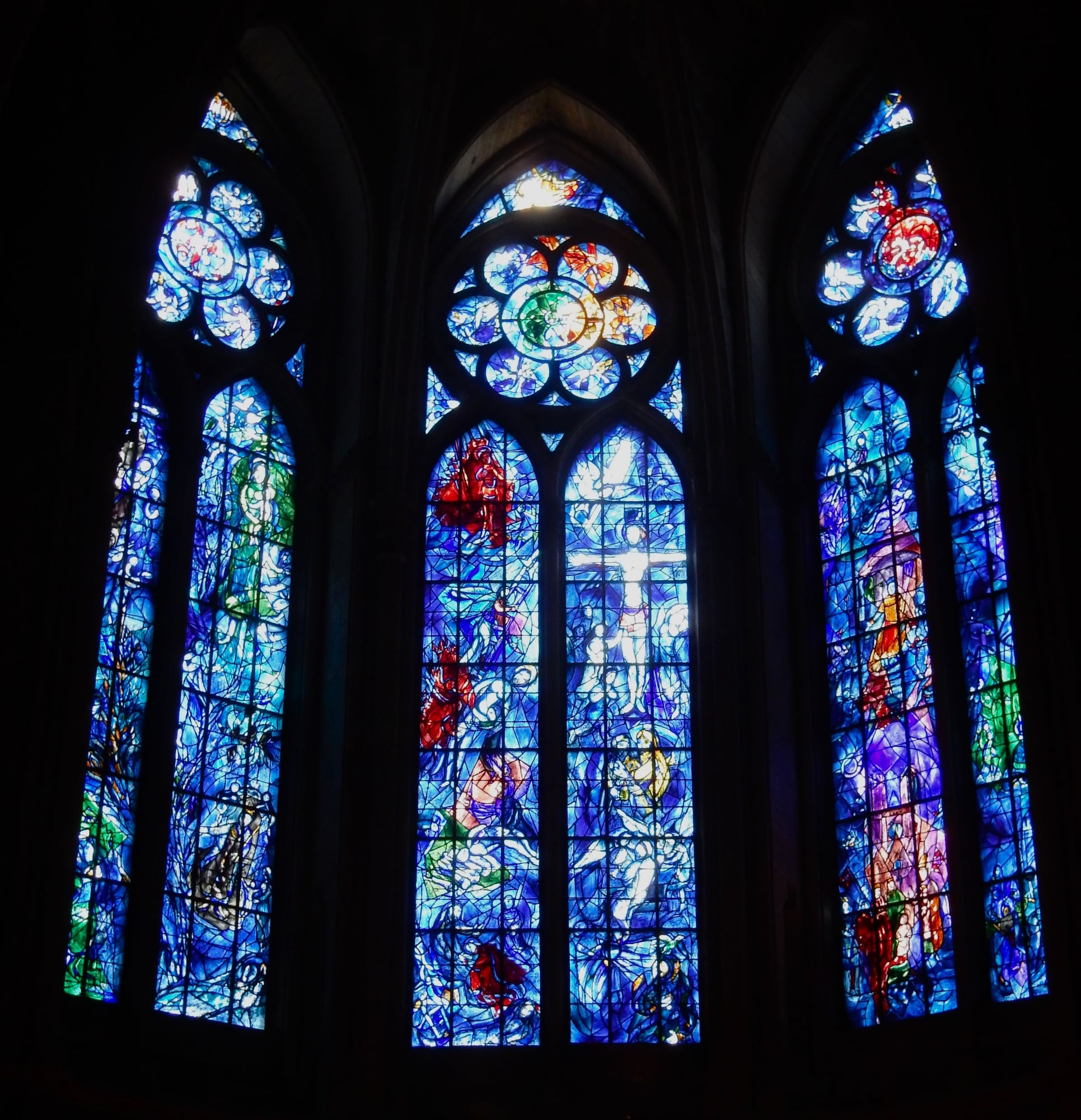
First, a couple from Port-en-Bessin. The first one is taken along the waterfront, just steps from our Gite, the next, just around the corner, with the lock leading to the inner harbor on the left, and the fishing boats in the background. Most of the restaurants are along this strip, but there are other along a side street.


A couple more photos from Pointe du Hoc:


A couple more from Mont Saint-Michel, of the abbey exterior and interior:


And, the Chagall stained glass at Reims:




